Animal Kingdom Non-Chordate Phyla Classification Of Animal Kingdom
There are about 1.2 million animal species which show a great diversity of life. Though the animals are metazoans like the plants they differ from plants in several characteristics like the absence of plastids, cell wall, and central vacuole; and having centrosomes in the cells.
These are exclusively heterotrophic and are mostly holozoic in their nutrition. These also pass through certain larval stages during their development.
Classification Of Animal Kingdom For NEET Criteria Of Classification
Habitat Mode of living and orientation of the body
- Aquatic. Those animals which live in water.
- Marine. Those animals which live in seawater.
- Freshwater. Those live in waters other than sea water Exampleponds, drains, ditches, lakes, rivers, slow or fast running streams, etc.
- Amphibious. Those animals which can live on land as well as in water, Examplefrog.
- Terrestrial. Those that live on land Exampleman, lizards, etc.
- Aerial. Those animals which can live in the air, Examplebirds and bats.
- Zooplanktons. These float on the water’s surface and are drifted by water currents Example small crustaceans like Daphnia, Cyclops, etc.
- Nektons. These swim actively in a sea or a lake Examplemost of fishes. Zooplanktons and the nektons which live in open waters, are collectively called pelagic animals.
- Benthos. These live on the bottom of water bodies Examples, are corals, echinoderms, etc.
- Out of these, sponges and corals are fixed to the substratum and are called sedentary or sessile animals.
- Neustons are animals floating or swimming in surface waters. Neritic are the animals found in coastal waters.
- Terrestrial animals. These animals live on land. They are again of the following types:
- Scansorial animals. These climb the walls, rocks, etc. Examples are lizards, flying squirrels, etc.
- Aerial animals. These can go in the air Examplemost for insects and birds, bats, etc.
- Cursorial animals. These are fast-runners Examplehorse, rabbits, lions etc.
- Pelagic. Living in the surface water of the sea.
- Arboreal. Those animals which live on trees and catch hold of tree branches Examplemonkeys.
- Burrowing (Fossorial). Those animals that form burrows in the sand or soil, for example – earthworms, snakes, some fishes, etc.
- Cave dwelling. Those which live in caves, for example- Lions and some fishes.
- Solitary. Those animals that live alone or single individually Exampleman, cats, dogs, etc.
- Colonial. Those which form colonies to live together, for example- Bees, ants, some coelenterates, (Physalia, Obelia), porifers (Sycon), etc Sedentary. These are fixed animals attached to substratum Example sponges, obelia, and
most coelenterates. - Free swimming. They swim actively in water. Sessile. These animals do not possess stalk. Sub-sessile. They possess stalk.
- Orientation of body
- Oval shaped. The shape of the body is like an egg.
- Cylindrical. The shape of the body is long and spherical, resembling a cylinder.
- Elongated. The body is long.
- Oblong. The body is oval and long (oval + long)
- Depressed body Dorsoventrally flattened body.
- Laterally compressed. Pressed laterally.
- Abond. Located away from, or on the opposite side of the mouth.
- Adoral. Located on the same side of the body surface as the mouth.
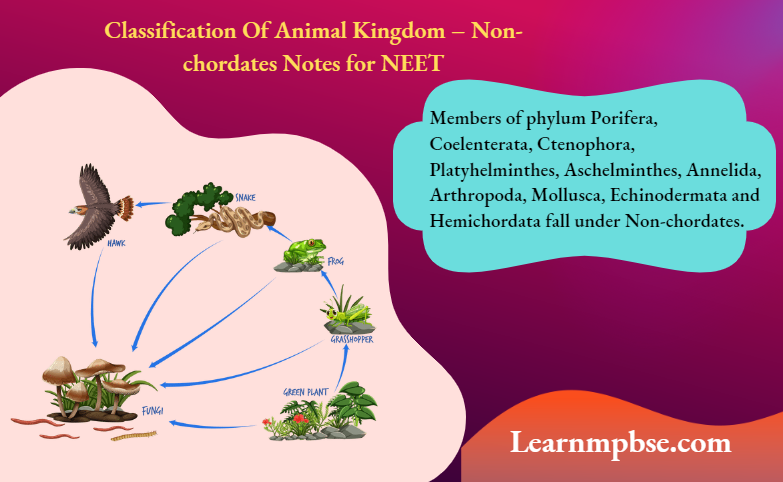
Body Segmentation
- Metamerically segmented body. A linear repetition of body parts is known as a segmentation (metamerism) example. Pheretima.
- Somite. Each repeated unit is somite.
- Appendages. Body pints protrude from the main body and serve in locomotion, feeding, mating, etc.
Skeleton
- Exoskeleton. Skeleton, which lies outside the body, for example- scales, feathers, nails, hairs, etc. It protects the body.
- Endoskeleton. Skeleton which lies inside the body, supports and protects internal organs, composed of cartilage or bone.
Detailed Notes On Non-Chordates Classification For NEET
Formation of mouth
- Protostonies. In most of the phyla (Platyhelmithes, Annelida. Arthropoda, Mollusca, and smaller groups), a tired mouth is formed in front of the blastopore of the embryo. These are called protostomes.
- Deuterostomes. In echinoderms, hemichordates, and chordates, the mouth arises remote front of the blastopore, and the latter becomes the anus.
Mode of running
Unguligrade
- Running on the tips of digits Example Horse, Rhinoceros, Ass, Zebra, Giraffe, etc.
- Plantigrade Walking on the palm of sole
- Digitigrade—Walking on toes Example Cat, Dog.
Level of organization
- Cellular organization. The animal body is formed of many cells but the cells show no coordination to form tissues Example sponges.
- Tissue organization. The animal body is formed of many cells that coordinate for the specific function and form four types of tissues Example epithelial tissue, connective tissue, muscular tissue, and nervous tissue Example coelenterates like Hydra.
- Organ-system organisation. The body is multicellular and cells coordinate to form tissues, organs, and systems Examples from flatworms to mammals.
Symmetry
Asymmetry- When the animal cannot be cut into two halves Example Amoeba. Radial or Biradial Symmetry. The radially symmetrical animals are mostly spherical or cylindrical. These can be cut into two halves, if we cut them through any radius of the animal, for example, most of the coelenterates and all the echinoderms.
Radial symmetry is again of the following types:
- Tetramerous Radial symmetry. When in radial symmetry, the body parts are arranged in fours or multiples of four Example Jellyfish.
- Pentamerous Radial symmetry. When in radial symmetry, the body parts are arranged in five or multiples of five Example echinoderms.
- Hexamerous Radial symmetry. When in radial symmetry, the body parts are arranged in sixes or multiples of six Example Sea anemone. In sea anemones, the body can be divided into two similar parts only by one or two vertical planes and have biradial symmetry.
- Bilateral symmetry. When the animal can be cut into two exactly equal and similar halves by one plane only Example Platyhelminthes to Chaetognatha and also vertebrates.
Sides in a Bilaterally Symmetrical Animal.
- Anterior side. It is that side of the body which is kept forward during locomotion.
- Posterior side. It is that side of the body that is opposite to the anterior side of the body.
- Dorsal side. It is the upper side of the body which is away from the substratum during locomotion.
- Ventral side. (L. Venter = belly). It is the lower side of the body which is towards the substratum during locomotion.
- Lateral sides. The right and left sides of the body are called lateral sides.
Body cavity
- Coelom. The body cavity is bounded externally by the parietal layer of the peritoneum and internally by the visceral layer of the peritoneum.
- Coelomate (Eucoelomate). The animals that possess true coelom. (True coelom is a cavity between the body wall and visceral organs and must be formed from mesoderm) Example Bryozoa.
Based on origin, coelom is of two types :
- Schizocoel. When coelom is formed by splitting of mesoderm Example annelids, arthropods, and mollusks. The animals having schizocoelic coelom are grouped in Schizocoela.
- Enterocoel. When coelom is formed from the enteron ofgastrula Example echinoderms and chordates. Such animals are grouped in Enterocoela. Acoelomate. These organisms lack coelom. They include all members up to phylum Platyhelminthes.
- Pseudocoelomata Animals in which false coelom is present. Body cavity, if present, develops from blastocoel, for example- Rotifera, Nematoda. Haemocoelomatas.
- In Arthropods and mollusks, the true coelom is reduced and the body cavity is filled with blood and is called hemocoel, and animals are termed haemocoelomates.
Modes of Respiration
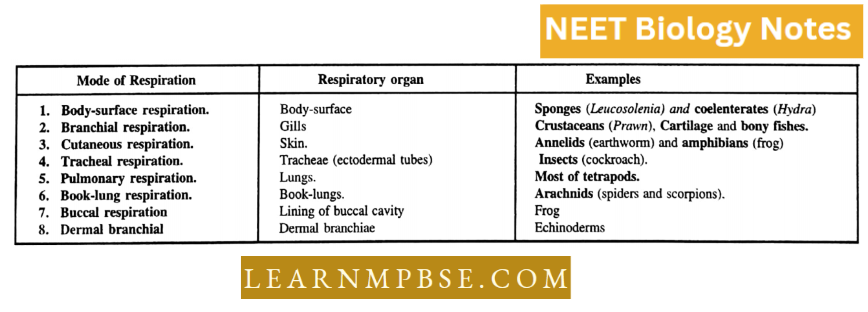
Modes of excretion
- Ammonotclism. When the main nitrogenous waste is NH3 the animals excreting ammonia are called ammonotelic animals. The water loss from the body along with ammonia is 300-900 ml/gm of NH3. It is found in aquatic animals Example Protozoans, sponges, coelenterates, crustaceans, echinoderms, and bony fishes.
- Ureotelism. The main nitrogenous waste is urea and the animals possessing it are called ureotelic animals. The loss of water along with urea is comparatively less. It is 50ml/ gm of urea. It is found in amphibians, mammals, and cartilage fishes.
- Uricotelism. The main nitrogenous waste is uric acid and animals possessing it are called uricotelic animals. Water loss is quite less and is just lOml/gm of uric acid. It is expelled as a semisolid paste. It is found in reptiles, birds, and insects.
- Mollusks like Limnaea, Unio, etc. are amniotic (expel amino acids) while certain bony fishes (especially teleosts) have trimethylamine as nitrogenous waste.
Cold-blooded or warm-blooded
- Homeothermal or Endothermic (Warm-blooded animals).
- In this, body temperature Is constant and does not change with the change in environmental temperature Example birds and mammals.
- Homeothermal Or endothermic (Cold-blooded animals). In this, body temperature is not constant and changes with changes in environmental temperature.
These defend themselves in two ways:
- Hibernation (Winter-sleep). In this, animals hide themselves in winter months and become inactive Example amphibians (frog; and lizards.
- Aestivation (Summer-sleep). In this, animals hide in shady areas during hot summer months. amphibians.
Detailed Notes On Non-Chordates Classification For NEET
Blood Vascular System
- Open type circulation Example Arthropods, mollusks.
- Closed type circulation Example. Annelids and most of chordates.
Body Plan
- Cell aggregate
- Blind sac and
- Tube in a tube body plan
Number of germ layers
- Diploblastic animals. In sponges and coelenterates, gastrula has two layers, outer ectoderm, and inner endoderm, so they are called diploblastic animals, for example, Porifers and coelenterates.
- Triploblastic animals. From flatworms to mammals, gastrula larva has three germ layers, outer ectoderm, middle mesoderm, and inner endoderm. So these are called triploblastic animals, for Example Platyhelminthes onward all phyla.
Reproduction
- Monoecious.When one individual of a species possesses both the male and female reproductive organs Example Pheretima, Taenia, Fasciola, etc. Hermaphrodite. It is a synonym or duplicate name of monoecious.
- Dioecious. When male and female reproductive organs are borne by separate individuals, the situation is called dioecious, for example- Man, Pila, Prawn, etc.
- Sexual dimorphism. If we can distinguish male and female individuals of a species by looking at their external features only, the phenomenon is called sexual dimorphism. Or, Males and females possess different shapes.
- PoIymorphism.The occurrence of at least tv/o, usually several, radically different body forms within colonial or social organisms.
- In unisexual animals, sperms and ova are derived from different animals, called cross-fertilization, In some bisexual animals, sperm and ovum of some animals fuse, called self-fertilization Example in Taenia.
- But in some bisexual animals, cross-fertilization occurs due to conditions: protandrous and protogynous. In protandrous conditions (Proto = first, android = male), testes mature earlier than ovaries Example leech, earthworm, etc.
In protogynous conditions (Proto =first, gynae = female), ovaries mature earlier than testes Example Scypha, and Herdmania (Sea squirt).
- Polygamy. When one male lives in the company of many females Example Struthio.
- Holoblastic Cleavage. The cleavage of the egg is complete; for example—in many invertebrates, amphioxus, amphibians, and mammals.
- Meroblastic Cleavage. The egg divides incompletely due to too much yolk in it The cleavage is confined to a limited portion of the egg, for example, Squids, insects, many fishes, reptiles, and birds.
- Metamorphosis. The larva undergoes certain changes to become adult, this process is called metamorphosis.
- Progressive Metamorphosis. When the larva is simple and becomes complex in the adult stage, for example- the Tadpole of a frog changes into an adult. Retrogressive Metamorphosis. When the larva is complex and more advanced than the adult.
- It loses its certain characters, for example –
- Ascidians. The larva has a well-developed notochord and nerve cord while these structures are absent and reduced respectively in adults.
- Monogenetic life cycle. When a parasite completes its life cycle in a single host Example Ascaris.
- Digenetic Life cycle. When a parasite completes its life cycle in two hosts.
- Pheromones. Secretions of glands are released in the air. These generally act as sex attractants.
- Autotomy. The ability of self-amputation.
- Regeneration. Ability to make up lost parts.
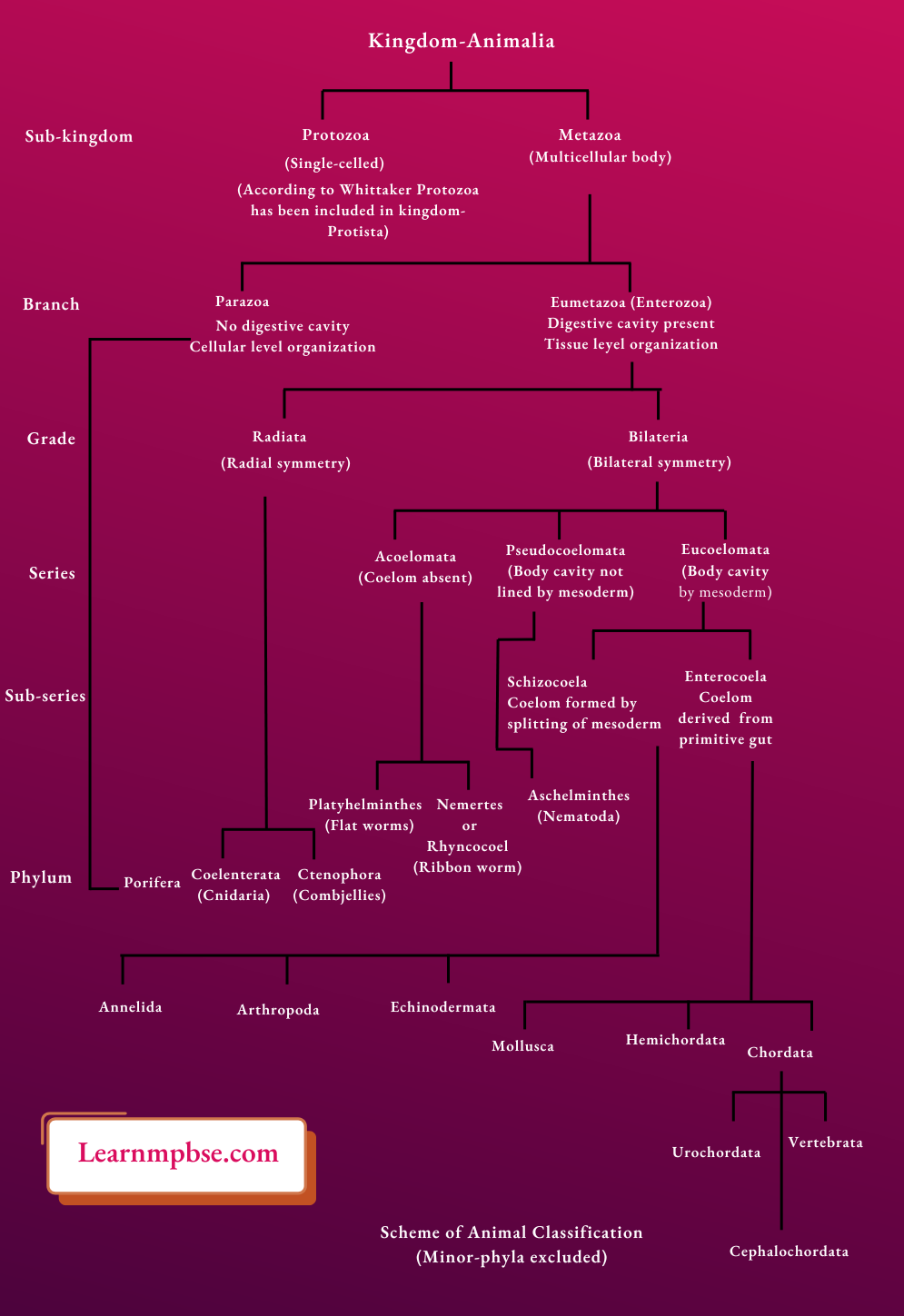
Classification Of Animal Kingdom For NEET Phylum Porifera
Unique features
- The canal system consists of pores, canals, and chambers facilitating the continuous flow of water for nourishment, respiration, excretion, and reproduction.
- Cellular organization within the body.
- Lack of oral cavity and gastrointestinal tract.
- Choanocytes, also known as collar cells, line the diverse passageways and spongocoel.
- Existence of spicules, spongin fibers, or both.
- The free-swimming larvae, termed parenchymula (Lcucosolenia & Clathrina) and amphiblastula (Sycon), function as a primary mode of dispersal for this predominantly sessile phylum.
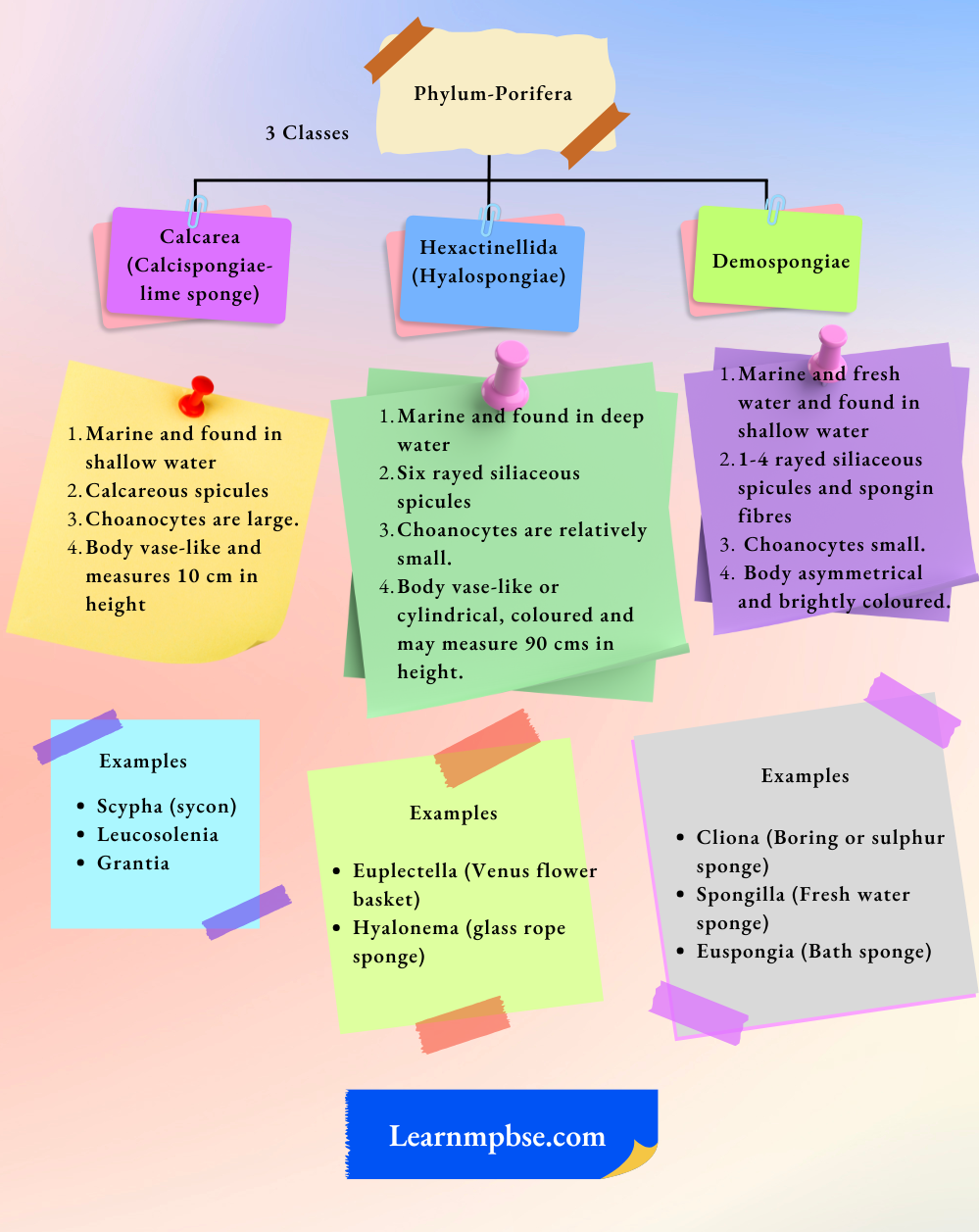
Classification Of Animal Kingdom For NEET Cells Of Sponges
- Choanocytes (also known as “collar cells”) flagellated cells which function as the sponge’s digestive system, are remarkably similar to the protistan choanoflagellates.
- The collar is composed of microvilli and is used to filter particles out of the water.
- The beating of the flagella of choanocytes’ creates the water current that enters the spongocoel.

- Pinacocytes. Form the pinacoderm, the outer epidermal layer of cells. This is the closest approach to true tissue in sponges.
- Porocytes. Tubular cells make up the pores in the sponge body through the mesohyl.
- Myocytes. Modified pinealocytes control the size of die and pore openings and thus (lie water flow.
- Archaeocytes (or microcytes). They are totipotent cells that can transform into. They also have a role in nutrient transport and sexual reproduction.
- Sclcrocylcs. Secrete calcareous or siliceous spicules that reside in the mesohyal.
- SpoiRocyles. Secrete spongin, collagen-like fibers which make up the mesophyll.
- Collcncytcs. Secrete collagen.
- Spicules. Stiffened rods or spikes made of calcium carbonate or silica are used for defense.
- Sensory anil nerve cells are absent in sponges.
- Spongioblasts. Spongin-fibre-secreting cells of sponges.
- Out of these, myocytes are derived from the dermal layer, while other amoebocytes are derived from the gastral layer.
- Cells are arranged in a gelatinous non-cellular matrix called mesohyal.

Position of Chomocytes
- Line the spongocoel in the Ascoiioid canal system.
- Line the radial canals in the Syconoid canal system.
- Line the flagellated chambers in the Lcticoitoid canal system.
- In the cavity of Eupleclella, a pair of crustaceans- Venusta spongicola lives till death.
- Prosopylc: An aperture between the incurrent and radial canal of Scypha.
- Apopyle: An aperture between a radial canal and an excurrent canal of Scypha.
- Geniniulation: Formation external buds in sponges.
- Gentmule: An internal bud of Spongilla. II is formed by a coat of spicules. It helps in perennation. Spicules- kinds.
- Rod-like or (long, short spear or club-like (excites)
- Three-rayed or Triradiate
- Tetaradiate
- Six rayed.
- Chemical nature.
- Calcareous or siliceous
- Costliest bath sponge – Spongia officinalis (natural sponge)
- Spongilla colony. Green in color.
- Gemmules are endogenous buds of sapodilla and help in asexual reproduction
- Euspongia. brown
- Spongia and Hippospongia provide bath sponges of commercial value
- The largest sponges belong to the class Demospongiae. A tropical logger-head sponge (Spheciospongia) forms a mass of over a meter in height and diameter
- Sponges are the lowest metazoans and arc placed in sub-kingdom Parazoa.
- Parazoology. Scientific study of sponges.
- Robert Grant. Coined the term Porifera.
- Ellis: Recognised the sponges as animals.
- The dermal ostia of sponges are analogous to mouths, while the osculum is analogous to the anus.
- The Mesogloea of the sponge is known as mesohyal or mesenchyme.
- Spongilla is a common and widely distributed freshwater sponge,
- Ieucosolenia is one of the simplest sponges.
Reproduction in sponges
Asexual reproduction
- By budding External/Exogcnous In budding, numerous archaeocytes collect at the surface and the placoderm bulges out to receive them. The bud so formed grows in an adult individual, ft either remains attached to the parent individual or gets detached and attached nearby to develop into an independent colony.
- Formation of gemmules (Internal/endogenous buds) All freshwater and some marine sponges (Ficulina, Tethya, Suherites, etc.) have a regular and peculiar mode of asexual reproduction by internal buds, called gemmules (Gr., gemma, bud).
- These eventually detach and develop into new individuals. Gemmules enable the sponges to tide over unfavorable conditions, such as excessive cold or draught, because they can withstand freezing and considerably greater degrees of desiccation than adult sponges.
- Fission-In some sponges, multiplication takes place by fission, throwing off parts of the body. The sponge is hypertrophied over a limited area, developing a line of weakness.
- Along this weak line, splitting occurs and a part is separated from the main parental body which develops into a new individual. By budding, this new individual takes the form of a colony.
- Formation of reduction bodies Another very unusual method of asexual reproduction is the formation of reduction bodies. Most freshwater and marine sponges disintegrate in adverse circumstances.
- The ailing sponge will usually collapse leaving small rounded balls, called reduction bodies.
- Each body consists of an internal mass of amoebocytes, covered externally by a pinacoderm. When favorable conditions return, these reduction bodies grow into completely new sponges.
Classification Of Animal Kingdom Non Chordates NEET Notes
Sexual Reproduction
- Sperms and ovum arc are derived from archaeocytes or choanocytes which undergo gametogenesis.
- Sperms are released outside through outflowing water and make their way into another sponge along with the ingressing water.
- Sperms arc carried by sperm-transit cells to the ovum.
- Fertilization is internal.
- The development includes amphiblastula or parencliymula larva.
- Amphiblastula is a hollow, oval larval stage, characteristic of many calcareous sponges (Example Scypha). Anterior one-half of amphiblastula bears flagella, whereas the posterior half does not.
- The parenchymula is a solid, oval, or flattened larval stage. It is characteristic of some calcareous, hexactinellid, and most demosopongians. The entire outer surface bears flagella.
- With the help of external flagella, the motile larvae escape from the parental body and swim for a few hours to many days. Finally, they settle down, become attached to some solid object, metamorphose, and grow into adults.
Classification Of Animal Kingdom For NEET Phylum-Coelenterata—(Cnidaria)
Unique features
- Tissue level of organization.
- Special kinds of stinging cells or cnidoblasts are meant for offense, defense, and food catching.
- Diploblastic, radially symmetrical, and mostly show polymorphism.
- The epidermis surrounds the cnidarian’s ‘stomach’ or gastrovascular cavity which functions as both mouth and anus. It is used both to ingest food and excrete waste.
- It also serves along with the mesogloea as a hydrostatic supporting skeleton. Firm skeletons are only found among polyps, which produce lime for that purpose.
- The gastrovascular system plays a role in the digestion and dispersion of food and the removal of metabolic waste.
- It surrounds the gastrovascular cavity as well as its extension in the tentacles of polyps. Thus the gastrovascular system serves two separate functions, digestion, and transport.
- Digestion is both intracellular and intercellular or extracellular.
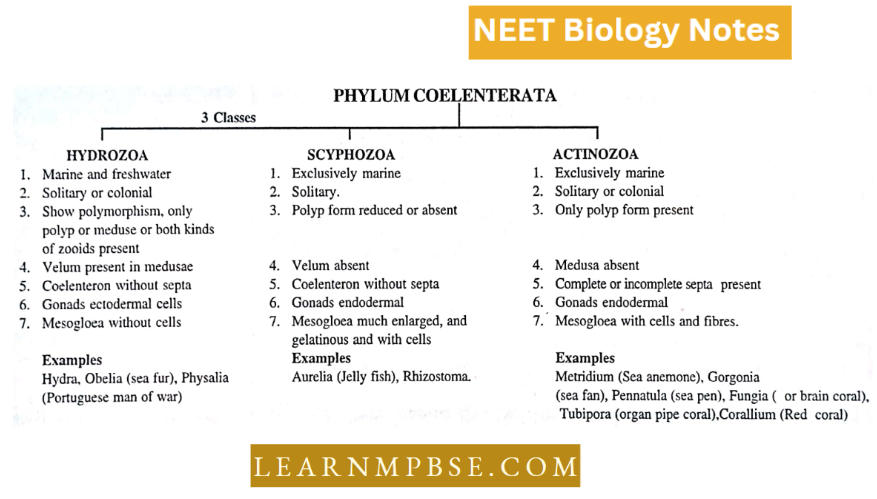
Classification Of Animal Kingdom For NEET Kinds Of Nematocysts
- Penetrants or Stenoteles. They are the largest.
- Volvent or desmosomes. They are the smallest, used only for obtaining food.
- Small glutinanLs or Alrichous or his, Butt absent and help in fixing loan object.
- Large glulinants or Ifolotrichous isorhiza. The long thread is open at the free end. They slick to an object.
Classification Of Animal Kingdom For NEET Hydra
Features of Hydra
- It is a fixed animal and is found attached to submerged weeds and stones. Though it is fixed, it can move about when required. If disturbed, it contracts to a small spherical or oval mass.
- It is carnivorous as its food consists of small crustaceans and larvae of insects.
- Digestion is intercellular as well as intracellular.
- Hydra has a slender tubular body and exhibits distinct radial symmetry. The body is extremely contractile and length varies from 10 to 30 mm.
- The lower end of the tubular body is closed and this side is designated as the aboral or proximal end. This side of the body is named a foot or basal disc.
- It is used as a structure for attachment to the substratum and it helps in locomotion.
- The opposite end (the distal or oral end) is free and possesses the opening of the mouth, situated at the summit of a conical elevation called the hypostome or manubrium.
- The manubrium is usually surrounded by several tentacles. The tentacles are fine hollow processes and help in catching food.
- The mouth leads into the coelenteron which occupies the interior of the body. It is continuous with the cavities of the tentacles.
- The epidermis and Gastrodermis are the two cellular layers of the body wall of Hydra. In between these two layers is also present a non-cellular jelly-like mesogloea.
- The epidermis is the outer protective layer and cellular. It forms nearly one-third of the thickness of the body wall. It consists of the following types of cells:
- Epitheliomuscular cells or
- Musculoepithelial cells
- Interstitial cells
- Cnidoblasts or Nematoblasts
- Nerve cells
- Sensory or receptor cells
- Germ cells.
- Nematocysts are of 4 types i.e. Penetrant (Stenotele), Volvcnt (Desmoneme), Glutinant streptoline (Holotrichous isorhiza), and Glutinant steroline (Atrichous isorhiza).
- Gastrodermis. It forms nearly two-thirds of the thickness of the body wall. It is always found forming the lining of the gastrovascular cavity. It consists of five types of cells:
- The nutritive muscular cells
- The secretory cells
- The sensory cells
- The nerve cells
- The interstitial cells.
Classification Of Animal Kingdom For NEET Useful Information
- Leukart Gave the term coelenterata.
- Peyssonel (1723): Reported the animal nature of coelenterates.
- Coelenterates are commonly called cnidarians due to the presence of cnidoblasts, so the study of coelenterates is called cnidology.
- Coelenterata name is due to the presence of the coelenteron cavity.
- Obelia is a trimorphic and marine colony.
- Planula larva is formed during the life cycle of Obelia.
- Coelenteron is present which is known as a gastrovascular cavity.
- Cell differentiation and Physiological division of labor are distinct in Hydra.
- Digestion is extracellular as well as intracellular.
- Respiratory organs, Blood, vascular system, and excretory organs are absent.
- The epidermis and Gastrodermis are cellular layers and are separated by mesogloea.
- Mesogloea is the non-cellular layer that is secreted by the epidermis and gastrodermis.
- Obelia and Aurelia show an alternation of generation and phenomenon of metagenesis.
- The main stem of Obelia is called the stolon which gives rise to hydrorhiza which is attached to a substratum.
- Most probably Triclwplax represents the most primitive living metazoans.
- Totipotent interstitial cells are the characteristic of Hydra.
- When development starts, obelia is a monomorphic form having polyp only but later due to the development of blastostyle it becomes a dimorphic colony and finally medusae but over the blastostyle in a mature colony, then it becomes a trimorphic colony.
- Some coelenterates can paralyze people swimming in the seas. ‘Sea wasp’ a coelenterate is one of the most poisonous animals.
Metagenesis. In the life cycle of Obelia, there is regular alternation between fixed polypoid and free swimming medusoid phases, both of which are diploid. Such an alternation between two phases is called metagenesis.
In metagenesis, the adult polyp forms male or female medusae (diploid) asexually.
There are three principal asexual events:
- Budding Strobilation occurs when a medusa forms on the higher (oral) end of the polyp, and is common among scyphozoa finally, complete metamorphosis, from polyp to medusa form can also occur.
- Some coelenterates that show polymorphism are Obelia, Physalia, and Velella. Physalia shows excessive polymorphism having gastrozooids, dactylozooids, and gonozooids.
- In India, medusae of Aurelia are commonly found in coastal waters of Madras.
- In the development of Aurelia (a jellyfish), both planula (larva) and ephyra (larva) are present.
- Obelia. Seafur, a marine, sedentary, and trimorphic colonial coelenterate.
- It has 3 types of zooids: nutritive and flower-like polyp enclosed in a hydrotheca; long and cylindrical mouthless blastostyle enclosed in a gonotheca; and umbrella-like dust with gonads and developed as a bud on the blastostyle. It is commonly called zoophyte due to its plant-like appearance.
- Corals are skeletons secreting anthozoans, while sea anemones are anthozoans with skeletons.
- Coral reefs. A coral reef is a ridge in the sea and is formed of skeletons of the coelenterates called corals. It is mainly formed of skeletons of stony corals like Madrepora but is impregnated by skeletons of Millipore and Tubipora.
It is mainly formed of calcium carbonate. These are of 3 types (by Hyman, 1940):
- Fringing reefs. These extend from the shore up a distance of 400 meters into the sea.
- Barrier reefs. These run parallel to the shore but are separated from slower by a water body called a lagoon. The largest barrier reef Great Barrier Reef in the north-east coast of Australia and is 1920 km long.
- Atoll. It is circular coral surrounding a quiet water body called a lagoon. It is also called Coral Island.
- In India, Lakshadweep islands are formed of coral reefs.
- These are mainly found in warm (70°F) and shallow waters of tropical seas. The Pacific northeast of Australia is called the Coral Sea.
- Corallite is the skeleton of an individual coral, while coenosteum is the colonial skeleton and is called corallum when it is branched.
- Corallium rubrum. Also called red coral (moonga), while Meandrine is commonly called brain coral.
- Rhizostoma. A polytomous scyphozoan with many mouth-bearing structures called scapulets.
- Aurelia. Three larval stages in the life cycle: Planula (ciliated for dispersal), Scliyphistoma (represents reduced polypoid stage and forms ephyrae by transverse fission called strobilation), and ephyrae.
Important Non-Chordates NEET Questions With Answers
Classification Of Animal Kingdom For NEET Phylum—Acnidaria Or Ctenophora
- Phylum Ctenophora was established by Hatschek (1839).
- Phylum Ctenophora is also called Aaiidaria as these lack cnidoblasts.
- Gastrodes parasiticum is only an endoparasitic ctenophore.
- Mesogloea ofctenoplwres is of collenchyma nature (with many cells).
- Ctenophora is a small phylum of marine coelenterates like free swimming and biradially symmetrical animals having 8 meridional rows of ciliary comb ribs.
- They are popularly called comb jellies, sea combs, and sea gooseberries.
- Cnidoblast are absent except Eucldora rubra.
- They possess phagocytes or light-producing structures, therefore are luminescent.
- Tentacles, when present, are solid and possess adhesive cells called colloblasts (= lasso cells).
- Ctenophores are acoelomates.
- The body plan is intermediate between the blind sac and tube within the tube.
- Animals are usually monoecious. An immature ciliated stage larva called cydippid larva is found in some forms.
- Ctenophoria has two classes- denticulate (with tentacles), Example Hormiphora, and nuda (without tentacles), Example Beroe.
Classification Of Animal Kingdom For NEET Phylum- Platyheminthes
General Characters of Phylum Platylielmintlies
- Body form. Body dorsoventrally flat, unsegmented leaf or ribbon-like.
- Germ layers. Triploblastie animals, with three germ layers ectoderm, endoderm, and mesoderm.
- Habitat. Mostly parasites with some five living forms.
- Symmetry. Bilaterally symmetrical.
- Level of Organisation. Body organization is at the level of organ and organ-system grade.
- In parasites, forms suckers and hooks are present lor attachment to host tissues.
- Body cavity. True body cavity absent i.c. acclimate.
- Incomplete alimentary canal present. In the alimentary canal, the mouth is present but the anus is not present. In some endoparasites alimentary canal is absent.
- Respiration is aerobic in free-living forms and anaerobic in endoparasites.
- Excretion is mainly ammonotelic. For excretion special cells called flame cells or protonephridia are present.
- Nervous system. Due to capitalization, a nerve ring is present.
- Sense organs. Photoreceptors are present in free-swimming forms.
- Reproduction. The reproductive system is highly developed and bisexual. It is an adaptation of a parasitic mode of life.
- The life cycle is usually complicated. It is again an adaptation to a parasitic mode of life
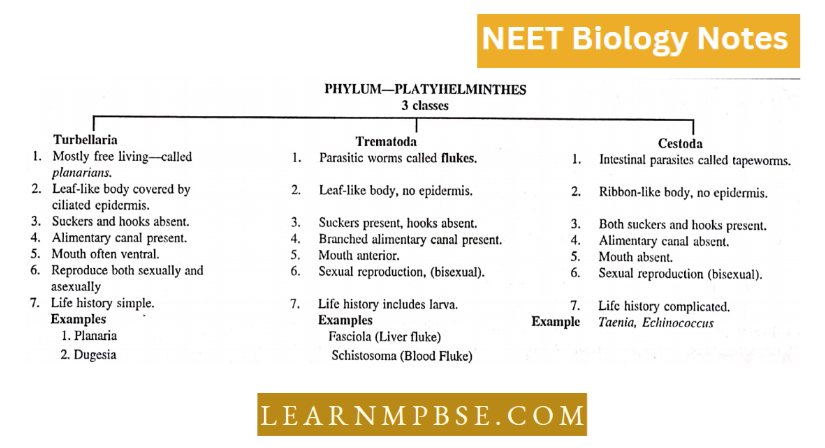
Classification Of Animal Kingdom For NEET Parasitism
It is an association between different species in which one is benefited and the other is harmed. The organism which is benefited is called a parasite and the other that suffers is termed a host. It is interesting to note that hosts can live without parasites but parasites cannot survive without hosts.
Types of parasites
- Temporary or partial parasites. These are animals that spend a brief period of their life as parasites and a major part as free-living forms.
- Examples: The Glochiditim larva of freshwater mussel is ectoparasitic on fishes for a short period, whereas the adult mussel is free living.
- Hymenoptera larvae are parasitic on caterpillars, whereas the adults are free-living.
- Permanent parasites. They are parasites throughout their life.
- Ectoparasite (External Parasite). They live on the surface Example Diplozoon indicum parasites on the gill of freshwater fishes.
- Endoparasites. Many live inside the host’s body Example Taenia in the intestine, Paragonitim in the lungs, Polystomium in the urinary bladder Fasciola hepatica in the liver, and Schistosoma in the blood. They live in the host body, within the cells. (Cytozoic), tissue (histozoic) or cavities (coelozoic).
- Monogenetic parasites (life cycle). Life history completed in a single host. Example Polystomum and Diplozoon.
- Non-pathogenic parasites. They do not cause any diseased conditions in the host body.
- Digenetic parasites. These parasites require two hosts to complete their life cycle.
- The host in which the parasite grows into its adult phase is called final, definitive, or primary while the one that simply serves to transmit the parasite from one definitive host to the other is called intermediate, secondary, or vector host.
- Accidental parasites. These are swallowed accidentally.
Examples: Soil and freshwater nematodes.
- Mode of infection of helminth parasite
- Swallowing of contaminated food.
- Boring through skin Example Schistosoma.
- Direct contact Example Diplozoon.
Adaptations of helminth parasite
Morphological Adaptation
- Loss of organs. Locomotory organs, digestive organs, sense organs.
- Continuation of pre-existing features. Thin flat body, shelled egg.
- Development of new structure. Adhesive organs tegument, sucking pharynx, cyst wall around infective larvae.
Non-Chordates Classification NEET Previous Year
Physiological adaptations
- Anaerobic respiration.
- Secretion of anti-enzymes and mucus.
- Evasion of the host’s immune system.
- Chemotoxin
- Excessive multiplication
Classification Of Animal Kingdom For NEET Fasciola Hepatica (Liver Fluke)
- Liver fluke lives as endoparasite in the bile ducts and canaliculi within the liver and remains attached by an oral and a ventral sucker (acetabulum).
- Upto 200 flukes may be present within a sheep. The mouth is situated in the oral sucker. No anus. Liver fluke is hermaphrodite (monoecious) but cross-fertilization takes place.
- There are two tests. Ovaries and vitelline glands are separate. Laurer’s canal is the temporary opening that receives the cirrus of the male during copulation.
- After fertilization eggs are laid in the bile ducts from where through the intestine they come out with the feces. The shell gland secretes the secretion which hardens to form the shell (capsule). Further development takes place in humidity.
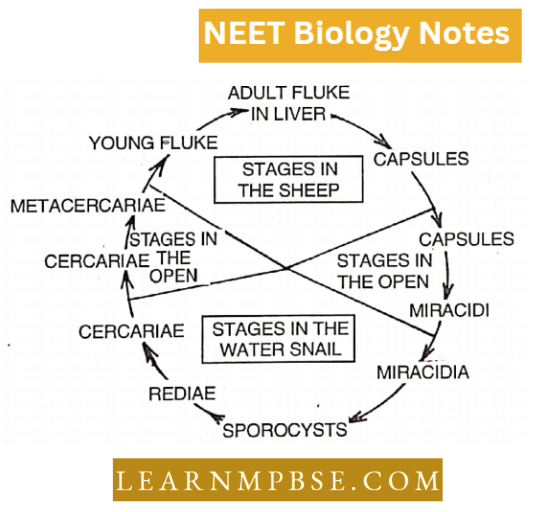
Life Cycle of liver fluke
- The life cycle is digenetic, the primary host is sheep and the secondary host is a snail.
- Eggs enclosed in capsules develop into miracidium larva which hatches in water and enters into the body of a snail (in digestive glands).
- Miracidium will die if it does not reach a suitable host within 24 hours of hatching.
- It develops into sporocyst larvae which form at least two aerations of 5 to 8 media larvae.
- Each media larva forms 14 to 20 cercaria larvae by its ns cells. Cerearia larvae come out of the body of the snail and swim with their tail.
- After some time they get attached to leaves of water vegetation and become encysted to the next larva i.e. metacercaria.
- When sheep feed on aquatic vegetation, metacercaria reaches the alimentary’ canal, where the cyst is dissolved by digestive enzymes and cercaria reaches the liver through the bile duct and develops into adult flukes.
- It causes fascioliasis or liver rot, anemia, and excessive edema of the jaws. Heterogamv.
- A kind of alternation of generations in liver fluke, in which there are alternations between sexual phase represented by adult worms and parthenogenetic generations represented by media and cercariae larvae. Polyembryony.
- In Liver fluke, the germ cells present in larval form are not eggs but they are diploid cells derived by mitotic divisions from propagatory cells separated from zygote. Thus zygote produces many larvae. It is termed as polyembryony.
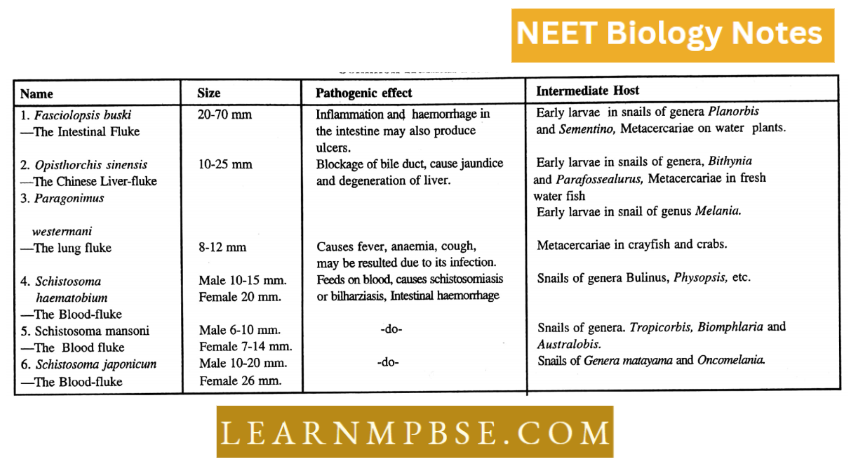
Classification Of Animal Kingdom For NEET Schistosoma Haematobium
Blood fluke
Commonly known as a blood fluke. It is a digenetic parasite, the primary host is man and the secondary host is Limnea (snail). It causes schistosomiasis or Bilharziasis. Males and females are separate. Females live in the gynaecophoral canal of males.
Classification Of Animal Kingdom For NEET Taenia Solium (Tapeworm)
- This lives as an endoparasite in the digestive tract where it is anchored to its mucosa by its scolex and absorbs the host’s digested food.
- It is found in all those parts where the pig is domesticated.
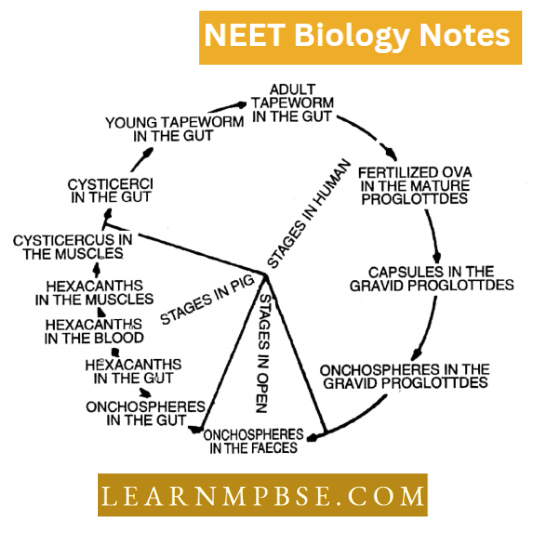
- Its body is opaque, flat, long, and ribbon-like, measuring 2.8 meters on average.
- The body is divided into Head (Scolcx), the unsegmented neck, and the segmented strobiln.
- The head has 4 muscularsuckers and two rows of hooks around the rostellum. The hooks and suckers are meant for attachment. The strobila has about 800-900 segments known as probiotics. These proglottids at the posterior end are sexually mature and known as grnvids.
- The gravids break off from the body and pass out with feces. This loss of gravity is made good by the neck which makes new proglottids.
- The body walls consist of a cuticle that rests on the body musculature that binds mesenchyme.
- Respiration is mainly anaerobic or anoxybiotic.
- The excretory system consists of lateral longitudinal canals, secondary canals, capillaries, and flame cells.
- Tapeworm is bisexual (hermaphrodite). Each proglottid has a large number of testes and a single bilobed ovary. Fertilization is internal and the zygotes are stored in a very much-branched uterus. There may be upto 30,000 zygotes present in the items of one gravid. The zygotes are covered with a thick layer of shell.
- Life Cycle. The gravids break off (apolysis) from the body and pass out with feces.
- If these feces are eaten by a pig, the zygotes reach into the alimentary canal of the pig. Each zygote produces an embryo with 6 hooks known as a Hexacanth embryo.
- The hexacanth embryo along with the shell is known as the oncosphere. The shell gets dissolved in the intestine of the pig, the hexacanths come out.
- These hexacanths pierce the wall of the intestine and enter into the bloodstream. The hooks disappear and each hexacanth embryo changes into a bladder-like structure known as a bladder worm (Cysticercus larva).
- These larvae now settle into the voluntary muscles of pigs. If a man eats such a pork which is highly infested with bladder worms, they reach into the intestine of the man and one of the bladder worms develops into a Taenia.
- Parasitic adaptation. Locomotory organs and digestive system absent Hooks and suckers present for attachment to host’s intestine Cuticle permeable for absorption of digested food from host’s intestine, Produces some anti enzymes which neutralize the enzymes and Taenia does not get digested itself, The osmotic pressure of the body fluids of Taenia is the same as that of man.
- Because there is one Taenia found in the intestine of one person hence it is bisexual, It produces a very large number of ova because there is a lot of wastage of ova in the feces, and Sense organs are very much reduced.
Classification Of Animal Kingdom For NEET Taenia Saginatathe, Beef Tapeworm
Taenia saginata is comparatively longer than Taenia solium and the scolex does not have rostellum and hooks. It has 4 muscularsuckers only. There may be upto 2000 proglottids present in the body. The intermediate hosts are cows and buffaloes. It causes Taeniasis and cycticercosis.
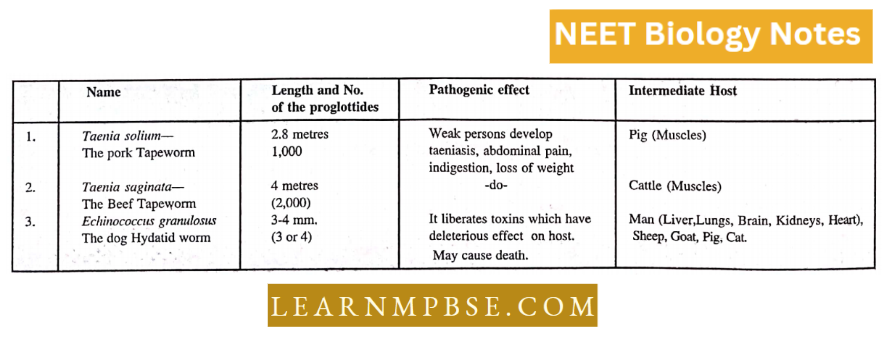
Classification Of Animal Kingdom For NEET Important Information
Turbellarians (Planarians).
- Dugesia is with a triangular head with two auricles, while Planaria is with a truncated head.
- The pharynx is protrusible through the mouth.
- Rhabditis: Rod-like bodies in the epidermal cells. Their secretion is probably protective and adhesive in function.
- The Planarian eye is an inverse eye in which light has to pass through the photoreceptors and then fall on pigment cells.
- Bipalium: Only terrestrial planarian.
- Morpholactic regeneration. One part of the body can form the whole body.
- Neoblasts: Cells of planarians that help in regeneration.
Classification Of Animal Kingdom For Neet
Trematodes (Flukes).
- Schistosoma (Blood-fluke). It is the only unisexual fluke found in the veins of man. Female is present in the gynaecophoral canal (a groove on the ventral side) of males. It causes schistosomiasis characterized by intestinal disorders. It is also called Bilharzia.
- Opisthorcliis sinensis. Chinese liver fluke of man.
- Paragonimus. Lung fluke of man.
Fasciolopsis buski: Intestinal fluke of man.
- Monogenetic flukes. With a monogenetic life cycle, for Example Diplozoon (ectoparasite of gills of fishes), Gyrodactylus.
- Digenetic flukes. With two hosts in the life cycle Example Fasciola, Schistosoma, etc.
- Prohaptor. Anterior sucker of flukes.
- Opisthaptor. Posterior sucker of flukes.
- Amphistomous flukes. Fluke with 2suckers, one at each end of the body Example Paramphistomum.
- Fasciola is with two testesand one ovary. Miraridium and cercaria are in free-swimming stages, while sporocyst and redia are inside the snail.
Cestodes (Tapeworms)
- Taenia saginata (Beef-tapeworm). It is found in the small intestine of man. The secondary host is a cow. Human infection is by taking undercooked measly beef. Its scolex is without hooks and rostellum while strobila is formed of about 2,000 proglottids.
- Taenia has a bilobed ovary and about 200 follicular testes.
- The world population suffers more from Taenia saginata than T. solium due to more beef eaters.
- Bothria: Longitudinal groove-like adhesive organs of tapeworms.
- Suckers. Cup-like adhesive organs.
- Onchosphere. Encapsulated larvae are found in the uterus of gravid proglottids.
- Apolysis. Loss of gravid proglottids from the posterior end of the body.
- Strobilation. Formation of new proglottids from the neck, also called
pseudometamerism. - Echinococcus. Hydatid worm. Its hydatid cyst shows exogenous as well as endogenous budding. Parasite of small intestine of dogs, cats, etc. It has only 3-4 proglottids.
- Diphyllobothrium. Largest tapeworm (18 m).
- Hymemolepis. Dwarf tapeworm (2-4.5 cm). It is a monogenetic tapeworm of man.
- Dipylidum. Dog tapeworm.
- Scolex is the adhesive part of tapeworms.
Classification Of Animal Kingdom For NEET Phylum Aschelminthes
General characters of Phylum Ascheliminthes
- Body form. Cylindrical body but circular, in outline in cross-section.
- Germ layers Triploblastic animals with three germ layers.
- Habitat, Some are free living and many are ectoparasites and endoporasites of animals as well as plants.
- Level of organization. Body organization is at the level of an organ system.
- Symmetry. Bilaterally asymmetrical.
- The body is covered with thick, tough, and spiny cuticles.
- The epidermis is syncytial.
- In the body fixed number of cells are present.
- The alimentary canal is complete and straight.
- Circulatory system absent.
- Respiratory system absent.
- Respiration is aerobic in free-living forms and anaerobic in parasitic forms.
- Special types of sense organs known as phasmids are present.
- The nervous system is well developed with a nerve ring, ganglia, and nerve cords.
- The excretory system is simple, formed of specially shaped cells.
- Excretion is ureotelic.
- Reproduction. Sexes are separate with a well-developed reproductive system.
- Shows sexual dimorphism. Usually, females are longer than males.
Classification Of Animal Kingdom For Neet
Classification of Phylum Aschelminthes.
- Class Nematoda (Sub-class Phasmida).
- Phasmid present, pouch-like sense organs and act as chemoreceptors present] Dracunculus medinensis (guinea worm), Rhabditis.
- Sub-class Aphasmida. Phasmids absent Example Trilobius, Trichinella (Trichinia worms) Trichuris (whipworm)
- Class 2. Nematophora e.g, Paragordius,
- Class 3. Rotifera Example, Philondina, Rotaria.
- Class 4. Kinorhyncha Example Echinoderes.
- Class 5. Gastrotricha Example Chaetonotus, Macrodasys.
- Class 6. Pripaulida
- Class 7. Acanthocephala
(These classes are now treated as separate phyla)
Classification Of Animal Kingdom For NEET Ascaris Lumbricoides (The Round Worm)
- This is the common roundworm found as a parasite in the intestine of man and also in pigs, cattle, sheep, and squirrels.
- Sexes are separate and show sexual dimorphism. The male is comparatively smaller than the female. The male measures 15 to 30 cm long with the posterior end curved, whereas the female measures 20 to 40 cm long and straight. Cloacal aperture is present in males whereas in females separate anus and vulva are present.
- There are 4 distinct lines present on the body of Ascaris in the form of folds known as Epidermal cords. (Dorsal, Ventral, and two lateral cords).
- The mouth is situated at the anterior end surrounded by 3 lips known as Dorsal Lip and 2 Ventro-lateral lips. The lateral papilla and amphid are present on each ventrolateral lip.
- Amphid is the chemo and olfactory receptor.
- Excretory pores are present above 2 mm away from the anterior end.
- The body wall consists of a cuticle (non-cellular), syncytial ectoderm, and longitudinal muscle.
- Highly vacuolated, fluid-filled pseudocolor present.
- The alimentary canal starts from the terminal mouth surrounded by 3 lips. The mouth opens into the pharynx which is bulb-shaped and lined by cuticles. From the pharynx begins the intestine which leads into the narrow rectum which opens outside through the anus.
- The alimentary canal of Ascaris is mainly concerned with absorption ofthe food rather than digestion.
- The excretory system is more or less H-shaped. Two longitudinal excretory canals are joined by a transverse canal.
- Male reproductive organs consist of a single long and coiled thread-like testis that opens into the vas deferens of almost the same diameter.
- The vas deferens opens into a wide seminal vesicle. It leads into a narrow ejaculatory duct which opens outside through the cloaca. There are present a pair of pineal spicules which help during copulation.
- Female Reproductive Organs are didelphic i.e. double. There are a pair of thread-like ovaries. Each ovary continues into a slightly thicker tube known as the oviduct The two oviducts open into a broad and muscular utero. The two uteri join together and open into the vagina. The vagina opens outside through the female gonopore or vulva, which is situated on the ventral side about one-third of the length from the anterior end.
- Life History. The sperms of Ascaris are amoeboid which brings fertilization of eggs in the uterus.
- The fertilized eggs are covered with 3 layers. A female Ascaris lays about 15,000 to 200,000 zygotes each day in the small intestine of a man. These zygotes pass out with the human feces.
- The larvae are known as rhabdoid larvae or first stage juveniles which are formed within the zygotes.
- The first-stage juveniles still live within the eggshell and molt after 10 days to produce 2nd stage juveniles (infective stage about 0.2 to 0.3 mm long).
- After rupturing the shell, 2nd juveniles come out and wander in the body for 25 days, undergo second and third molting in the alveoli of the lungs, and by the time 4th stage juveniles are formed again and reach the alimentary canal where they grow into adults. In the intestine, they molt for the fourth time and grow into adults in about 2 to 3 months.
Classification Of Animal Kingdom For NEET Life Cycle Of Ascaris
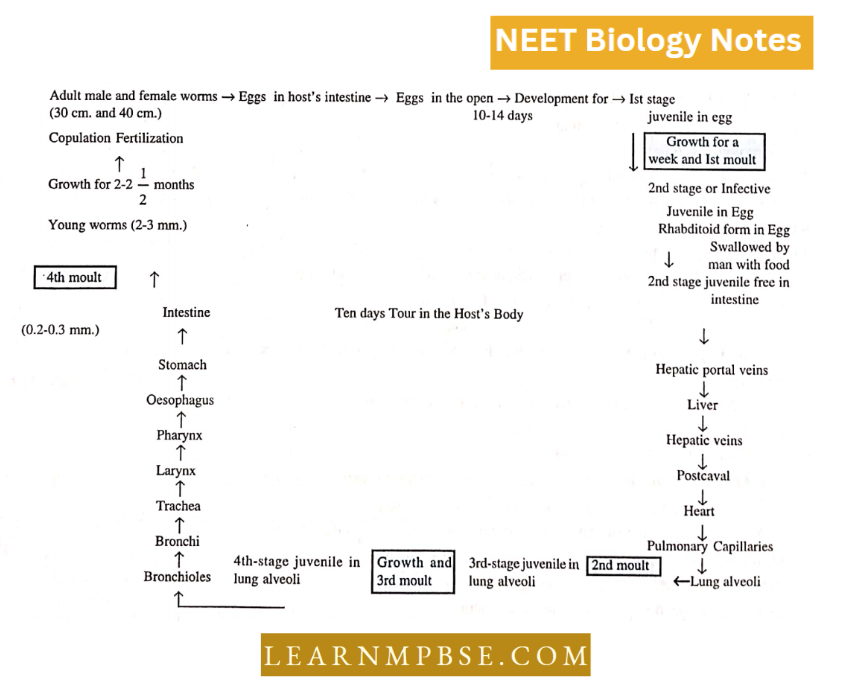
Classification Of Animal Kingdom For NEET Wuchereria Bancrofcit
Human filarial worm
- It is predominantly located in tropical climates.
- Wuchereria is a dimorphic intercellular endoparasite of humans.
- Wuchereria inhabit the lymphatic arteries and lymph nodes of humans.
- Wuchereria bancrofti, sometimes referred to as Filaria bancrofti, induces elephantiasis disease (Filariasis).
- In filariasis, lymphatic tubes and glands become inflamed and clogged, resulting intissue enlargement due to the accumulation of lymphatic fluid. Infection by Wuchereria (filaria) occurs via the Culex mosquito.
- The life cycle is digenetic in nature.
- Both male and female forms entwine with one another.
- Culex fatigans and Culex pipiens act as secondary hosts for Wuchereria.
- Female Wuchereria produce sheathed embryos known as microfilariae.
- Microfilariae are elongated, slender entities encased in a translucent sheath.
- Microfilariae enter the superficial blood circulation at midnight and are transmitted into the body of a mosquito (Culex) during the bite.
- Microfilaria transforms into sausage-shaped larvae within the thoracic musculature of mosquitoes.
- Microfilariae undergo two molts within the thoracic muscles of mosquitoes, transforming into elongated, slender forms.
- Long, slender microfilariae represent the infective stages that are subsequently transmitted within the primary host, namely humans.
- Significant pharmaceuticals include Antimony and Arsenic compounds, which eliminate both adult forms and microfilariae.
- The lifespan of Wuchereria is four to five years.
Ancylosloma (Hook worm)
- Ancylosloma is the worm of man.
- Ancylostoma is monogenetic.
- The Cloaca of the male is surrounded by a copulatory bursa. Hookworm causes Ancylostomiasis in which a person suffers from acute (severe) anemia.
- The free larval stage is found in the life cycle of hookworms.
Trichuris trichiura (whip worm). Endoparasite of caecum and large intestine of man. Heavy infection causes diarrhoea and anemia.
Rhabditis maupasi. A free living soil nematode.
Loa (Eye worm): Commonly found in subcutaneous tissue in Africans. These pass across the eyeball.
Enterobius (Oxyuris). Pinworm. An endoparasite of the large intestine of man. It is monogenetic. It causes enterobiasis characterized by sleeplessness, digestive and mental disorders, abdominal pain, etc.
Animal Kingdom Neet Previous Year Questions
Trichinella (Trichina worm). An intestinal endoparasitic worm ofman. Reservoir hosts are pigs, dogs, cats, etc. Larvae become spirally coiled in the voluntary muscles. It causes trichinosis characterized by nausea, muscular pain, etc.
Dracunculus (Guinea worm). An endoparasitic worm of subcutaneous tissue is digenetic and its secondary host is Cyclops. It causes guinea worm disease characterized by itching, diarrhea, nausea, vomiting, etc. It is the earliest known nematode and was earlier called the “Fiery Serpent.”
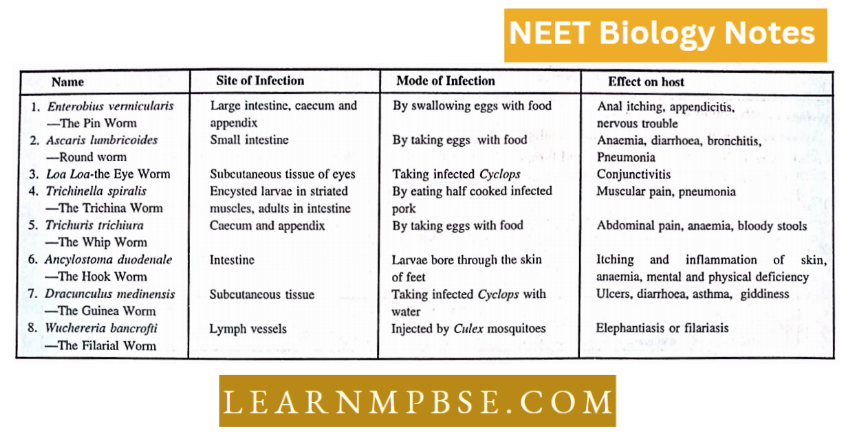

Classification Of Animal Kingdom For NEET Phylum Annelida
General characters of Phylum Annelida
- Triploblastic animals.
- Bilaterally symmetrical.
- Found in water and moist soil.
- Mostly free swimming, some are parasites
- True coelom is present for the first time in the animal kingdom. Coelom is shizocoel.
- True metameric segmentation is present.
- Annelids have a complete and straight alimentary canal.
- Annelids show tubes within the tube body plan.
- Locomotory organs are setae or parapodia or suckers.
- In the body wall, both circular and longitudinal muscles are present.
- Blood vascular system closed type.
- Respiratory pigment is hemoglobin, which is dissolved in plasma.
- Respiration either by moist body surface or parapodia or gills is present.
- Nephridia are present for excretion. Nephridia are metanephridia.
- The nervous system consists of a nerve ring, double, solid, ventral nerve cord, and segmental ganglia.
- Sense organs are of many types such as photoreceptors, olfactory receptors, etc.
- Sexes usually united i.e., hermaphrodite.
- Reproductive organs develop from coelomic epithelium.
- Development may be direct or indirect.
- The larva, if present, is a trochophore larva.
Unique features
- Metameric segmentation
- True coelom lined by mesodermal epithelium filled with coelomic fluid which acts as a hydraulic skeleton
- Excretory and osmoregulatory structures are nephridia
- The presence of circular and longitudinal muscles both in the body wall and wall of the gut
- Closed circulatory system with respiratory pigment dissolved in plasma
- Development may be direct or larva if present is trochophore larva.
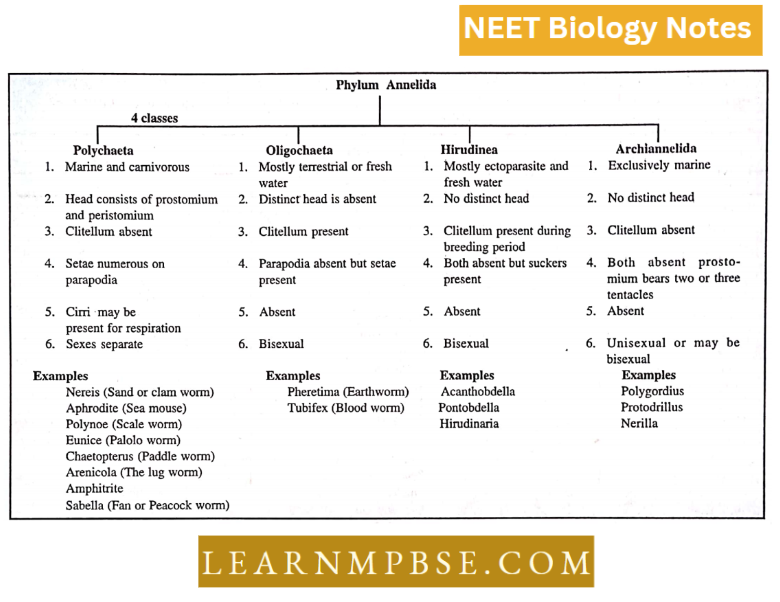
Classification Of Animal Kingdom For NEET Important Information
Class Oligochaeta
- Chloragogen cells or yellow cells of earthworms are analogous to vertebrate liver cells.
- The brown color of earthworms is due to the pigment porphyrin present in the body wall and coelomic fluid.
- It protects the body from bright sunlight. Lumbricus is the earthworm of Europe and North America; Megascolex is found in South India while Eutypliaeus is found in the Gangetic plain of North India.
- Clitellar glands are maximum in clitellar segments and secrete ootheca.
- Setae are absent in the first, clitellar and anal segments.
- The coelomic fluid of earthworm is with five types of coelomocytes: Phagocytes (largest sized and most numerous); leucocytes, melanocytes, circular cells, and yellow cells.
- Yellow cells, also called chloragogen cells, store glycogen granules so are analogous to hepatocytes of the liver. Some suggest that these are excretory in function.
- Typlilosole: A large-sized fold in the middle part of the intestine and increases the face area of absorption.
- In earthworms, there are 4 pairs of hearts, one pair in each of the 7th, 9th, 12th, and 13th segments. The anterior two pairs of hearts are called lateral hearts, while the posterior two pairs of hearts are called latero-oesophageal hearts.
- Scptail nephridia of earthworm mid nephridia of Nereis arc called metanephridia as each opens In coelom by nephrostome.
- Earthworm In excretion (40% tire).
- In the nerve cord, there are 4 giant nerve fibers which help in reflex actions,
- Receptor organs of earthworms are formed of modified epidermal cells.
- The male reproductive system is formed of two pairs of testes (one pair In each of the 10th and Ith segments) and is enclosed in respective testes sacs (two in number). Prostate glands are one pair while accessory glands are 2 pairs (one pair in each of the 17th and 19th segments).
- The female reproductive system includes one pair of uncovered ovaries (in the 13th segment). Spermal Uecae is 4 pairs (one pair in each of the 6th, 7th, 8th, and 9th segments) and stores the sperms received during copulation.
- Tubifex (blood worm) A darkly red-colored oligochaete (with a large amount of hemoglobin in blood) that can survive even in a highly 02- deficient and polluted fresh-water body.
Animal Kingdom Neet Important Points
Class Polycliaeta
- Nuchal organs. Olfactory and chemosensory pits on prostomium behind the eyes. These help the worms to detect the prey.
- Gonads are temporary structures and develop only during the breeding season.
- Nephromixia. Nephridia which act as excretory as well as genital ducts. The term nephrotoxic was coined by Goodrich (1945).
- Epiloky. Transformation of a non-sexual into a sexual polychaete. The posterior part of the body with gonads and parapodia with leafy outgrowths and oar-like setae is called epitoke, while the anterior non-modified part is called matoke.
- Trochophore larva is with two ciliated bands: Prtotrocli and telotroch, which help in dispersal
- Aphrodite. Commonly called sea mouse, while Polynoe is called scale worm.
- In Eunice (Potato worm), epitoke is regenerated several times.
- Chactoplertis (Paddle worm) A tuberculous, marine polychacte. It has 3 fan-like notopodia in the middle part of the body which beat and maintain a water current.
- Arenicola (Lugworm), Amphitrite, and Tcrcbella are polychaetes that have gills for respiration.
- Nereis has a closed circulatory system but no heart.
Class Hirudinea
- luminaria granulosa (Indian cattle leech) :
- The skin of leech is with numerous mucus-secreting gland cells.
- A clitellum is formed by the 9th, 10th, and 11th segments during breeding season.
- Nephridiopores are 17 pairs (one pair on the ventral side of each of the 6th to 22nd segments).
- Leech has 3 jaws (jaw with a single row of denticles).
- Hirudin. An anticoagulant in the saliva of leech.
- The crop is the largest part of the gut. It is 10-chambered and stores the blood.
- True coelom in leech is reduced and enclosed in testes sacs and ovisacs.
- Leech has 17 pairs of nephridia and are of 2 types:
- 11 pairs of testicular nephridia (one pair in each from the 12th to 22nd segment).
- 6 pairs of pre-testicular nephridia (one pair in each of the 6th to 11th segments)
- Ciliated organs of nephridia have no excretory function but manufacture coelomic corpuscles of the haemo coelomic system.
- Leech is ammonotelic in excretion.
- Leech has 11 pairs of testis sacs, one pair in each segment from the 12th to the 22nd segment, but has only one pair of ovaries in the 11th segment.
- Spermatophore. Bundle of sperms.
- Pontobdella (skate sucker) is a marine leech that sucks the blood of skates, rays, and sharks.
- Hirtido medicinalis The medicinal leech of Europe is a fresh-water leech.
- Phlebotomy. Method of blood-letting to suck the impure blood by applying an icon-hungry leech to the skin.
Classification Of Animal Kingdom For NEET Phylum Arthropoda
General characteristics of Arthropods
- Habitat. Arthropods are found in all types of habitats. They may be aquatic or terrestrial the insects have taken to the aerial mode of life.
- Germ layers. Triploblastic i.c. ectoderm, mesoderm and endoderm.
- Symmetry. All arthropods show bilateral symmetry, having distinct dorsal, ventral, and lateral sides.
- Body plan. Like all higher animals arthropods show tube-within-tubc plan of the body.
- Level of organization organ system level.
- Exoskeleton. The body is covered by a chitinous exoskeleton which may be impregnated with calcium salts. Chitin is a polysaccharide. The chitinous exoskeleton is largely responsible for the success of arthropods to live on land, it protects the body and prevents the loss of water.
- Body Regions. The body is usually distinguished into the head, thorax, and abdomen.
- The presence of the head is an important advancement and is called cephalisation. In many species, the head and thorax are fused to form a cephalothorax, for Example, Prawn, and Crayfish.
- Segmentation. Arthropods are segmented externally. The segments in the anterior region get fused to form the head. However, the body cavity is not partitioned by septa.
- Jointed Appendages. The most important feature of the phylum is the presence of paired jointed appendages. They are modified according to their function. For example, insects have three pairs of jointed legs on the thorax which are used for walking, in crayfish and prawns they are modified for swimming. Some of them are specialised for feeding while others are applied for sensory and reproductive purposes.
- Wings. The insects are the only non-chordates that can fly due to the presence of two pairs of wings arising from the dorsal side of the thorax. However, some insects, for example, Silverfish and Head louse lack wings. The wings are simply outgrowths of the body wall.
- Digestive system. The alimentary canal opens at both ends of the body and is distinguished into three regions, the foregut, mid-gut, and hindgut.
- Body Cavity. The body cavity is called hemocoel. It lacks a regular layer of mesodermal lining and contains blood.
- Circulatory system. The circulatory system is of open type. The blood directly lies in the body cavity, and there are no closed vessels.
- Respiratory organs. Aquatic forms respire by gills. The terrestrial arthropods such as insects breathe employing certain branched tubular organs called tracheae which ramify throughout the body, and communicate to the outside by certain openings called spiracles.
- Excretory organs. The excretory organs in insects are the malpighian tubules. In crustaceans, the excretion is by green glands or antennary glands.
- Nervous system. It resembles that of annelids and consists of a brain and ganglionated ventral nerve cord.
- Sense organs. The sense organs are well developed. They include compound eyes for sight, and sensilla for smell, hearing, and taste.
- Reproduction. Arthropods reproduce only sexually. Sexes are separate, and the male and female are externally distinguishable.
- Fertilization is internal. Life history usually involves a larva or nymph. The larva (or nymph) later changes into an adult. The phenomenon is called metamorphosis.
Classification Of Animal Kingdom For NEET Unique Features
- Jointed appendages are modified for performing various functions such as feeding, walking, flight, sensory; copulation, egg laying, etc.
- The hard exoskeleton of chitinous plates for protection and also provides a hard surface for attachment of muscles
- Tracheae for respiration in most eases. In other forms gills, book gills, and book lungs act as respiratory organs.
- Malpighian tubules or coxal glands as excretory organs for excretion.
- Compound eyes are formed of optical units called ommatidia.
- Presence of hemocoel
Classification Of Animal Kingdom For NEET Mouth-Parts Of Insects
- Biting and chewing type Orthopteran Example Grasshopper, cockroaches, crickets, silverfish, Booklice, bird lice, earwigs, termites, Hymenoptera, especially caterpillars, bedbugs, and beetles.
- Piercing and Sucking
- Mandibles, Maxillae constitute needle
- Labium – hollow grooved channel Example Mosquitoes
- Chewing and lapping type Example Honey bees
- Sponging type Example houseflies and other flies
- Siphoning type. Butterflies and moths.
Classification Of Animal Kingdom For NEET Metamorphosis In Insects
- No metamorphosis or Ametabolous development Example silverfish, springtails egg Adult
- Incomplete metamorphosis or hemimetabolous development
- Egg → Naiad→ Adult
- Example Mayflies, Dragonflies, stone flies
- Gradual metamorphosis or paurometabolous development
- Egg→ nymph → Moulting Adult
- Example Grasshopper, Aphids, Stink bug
- Complete metamorphosis or Holometabolous development
- Egg → Larva Pupa → Adult
- Example Housefly, Mosquito, butterfly
Animal Kingdom Neet Previous Year Questions
Hormonal Control
- Brain hormone (BH) – (LIPID)
- Activates the corpora cardiaca—a component of retrocerebral complex.
- Prothoracicotrophic hormone (PTTH) is secreted in corpora cardiaca which in turn stimulates Prothoracic glands.
- Prothoracic gland hormone (PGH) (Ecdysone) Trigger molting.
- Juvenile hormone (JH)
- Secreted by corpora allata (non-sterolic lipid). Promotes metamorphosis.
Larvae Of Crustaceans
- Nauplius—Cyclops. Ii may give rise to intermediate larval forms
- Mctanauplius—Apus
- Protozoea—Penacus
- Megalopa—True crab
- Glamcothel—Hermit crab
- Schizopod—Lobster
- Cypris—Lcpas, Sacculus
- Alima—Squilla
- Phyllzosoma—Spiny lobster
- Zoea.
Classification Of Animal Kingdom For NEET Economic Importance Of Insects
- Poisonous Insects. Examples are Honeybees, wasps, hornets, fire ants, bed bugs, mosquitoes, and a few lepidopterous and other larvae.
- Disease carriers
- Species of Anopheles spreads Malaria.
- Culex mosquitoes spread nematode worm Filaria which causes Filariasis.
- Stergomyia mosquitoes spread Yellow fever
- Taparus fly spread surra disease among horses and camels.
- African sleeping sickness by tse tse fly (Glossina)
- Housefly spreads diarrhea, cholera
- Fleas spread bubonic plague
- Bed bugs and Body Louse spreads Relapsing fever
- Productive Insects
- Honey and bees wax by Honey Bee (Apis indica)
- Wax produced by scale insects
- Commercial silk by silkworms (Bombyx mori)
- Lac is produced by lac insect (Kerria laced)
- Shellac secreted by coccidae.
- Dyes and tannin are obtained from cochineal dried bodies of certain scale insects.
- Insects in Medicines
- Cochineal Insect contains carminic acid concern, myricetin, fat, and fatty acids used for neuralgia and whooping cough.
- Browfly larvae are used in treating the decay of the tissue.
- Cantharidine oil obtained from blister beetle,
- Bods’ extracts of the cocoon of silk moth used for treating leucorrhoea,
- Bee venom is used for
- Arthritis and
- Antivenom for snake bite
- Honey. Natural Antiseptic used to cure ulcers.
- Bee wax. Base for ointments.
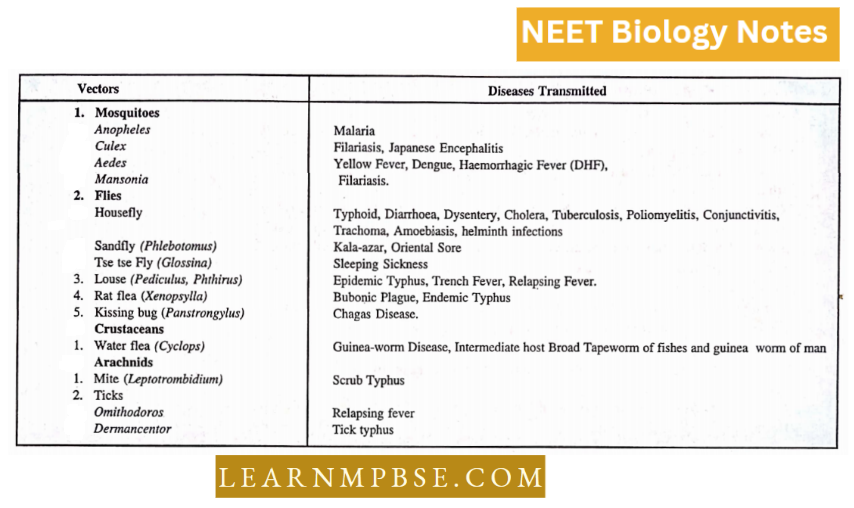
Classification Of Animal Kingdom For NEET Important Information
- Larvae of the genus Chironomus (an insect) are called blood worms. They have red blood. The red color of these larvae is due to hemoglobin.
- In coastal areas like Konkan Maharashtra of India, the red and black species of scorpions are deadly poisonous. Their venom is fatal.
- Honey is flower nectar mixed with the saliva of bees and is a natural antiseptic.
- Bees communicate by complex dance.
- Royal Jelly—a substance secreted by honey bee workers.
- Termites are social and polymorphic insects.
- Termites form large nests called crematoriums.
- Usually the larger an animal is, the longer it takes to grow up. One exception is the 17-year cicada (an insect), which spends a very long time as a larva.
- In spiders, the web is secreted by the last body segment.
- The thread of the spider web is stronger than steel thread.
- The endoskeleton is present in the head and thorax of the cockroach. The abdomen has no endoskeleton.
- In all insects the intervals between two eedysis (casting of skin) is known as the stadium and the form assumed by the young insect during a stadium is called an Instar.
- Mites are parasites of animals as well as plants
- Fireflies or glow worms bear light-producing organs upon their abdomen. Light is emitted at short intervals by both males and females as a visual signal to attract each other for copulation.
- Gambusia is a larvivorous fish that feeds on up larvae of mosquitoes.
Classification Of Animal Kingdom For NEET Selected Arthropods Class Crustacea
- Daphnia. Its body is covered by a bivalved carapace and is commonly called a water flea.
- Cyclops Commonly called one-eyed monster (with the simple median eye). The female is with ovisacs and carries the eggs. Serves as a vector of Dracunculus nematode.
- Cypris. Commonly called mussel shrimp. A microscopic fresh-water crustacean showing cutaneous respiration.
- Barnacles are sedentary crustaceans Example Liyas. Called a Ship or goose barnacle. A pedunculate crustacean. Carapace is with 5 calcareous plates.
- Balanus. Called Acorn or Rock Barnacle. A sessile crustacean. Carapace is with 5 calcareous plates.
- Sacculina. Called a root-headed barnacle. An ecotoparasite of crab and highly degenerated crustacean due to retrogressive metamorphosis. Induces the development of female characters in infested male crab, called parasitic castration. Squilla is commonly called mantis shrimp as preys upon small marine fishes, crustaceans, mollusks, etc.
- Palinums. Marine spiny or rock lobster as carapace with many spines, Edible.
- Eupagurus (Hermit crab): Shows proto-cooperation with sea anemone (Adamsia).
- Palacmon (Prawn).
- P. carcinus is giant prawn (90 cm), while P. Lamarr is dwarf prawn (2.5-5 cm).
- Statocysts (one pair) are organs of balance and lie in the basal segment of each
antennule. - Epimeron. A scaly plate which joins an appendage with the pleuron.
- Biramous appendage. An appendage in which a basal segment called
- Protopodite gives two outgrowths: inner endopodite and outer exopodite.
- Uniramous appendage: When protopodite gives rise only endopodite but there is no exopodite.
- Cephalic appendages of Prawn are 5 pairs (one pair each of antennules, an tennae, mandibles, maxillidae and maxillae).
- Thoracic appendages are 8 pairs (5 pairs of legs and 3 pairs of maxillipeds).
- The digestive gland of crustaceans is hepatopancreas which combines the functions of the liver, intestine, and pancreas.
- All the gills of Prawn are Phyllobranchcs (gill axis with 2 rows of leafy gill lamellae).
- The heart of a Prawn is arterial as it receives and distributes oxygenated blood.
- Prawn shows apposition or mosaic vision in bright light and superposition vision during dim light.
- Prawn fishery: Capturing of prawns from natural resources as well as their culture.
- Prawn is a rich source of proteins and A and D vitamins but has low fats. Pcnaeus indicus (about 23 cm. long) is the most important commercial prawn species in India.
- Lobster tail. The abdominal region of spiny lobsters is used as food.
- Central Marine Fisheries Research Institute is located at Narakkal (Cochin).
- Oniscus. Only terrestrial crustaceans.
Class Insecta
Sub-class Diplura
- Eleven segments in the abdomen of both immature and adult. Segmented antennae.
- Cerci present, Malpighian tubules absent or vestigial. Primarily wingless. A widely distributed order living in concealed habitats, often in the soil.
- Sub-class Protura Abdominal segments were added successively through post-embryonic growth, making a final complement of eleven segments plus a posterior telson.
- Antennae absent. Malpighian tubules are present but rudimentary. Primarily wingless. Minute, whitish insects widely distributed, found in moist litter, bark, etc.
Sub-class Collembola
- Abdomen with six segments only, usually with three sets of appendages, a ventral tube on segment 1, and a retaining hook on 3 which functions with a powerful springing organ on segment 4. No metamorphosis.
- The tracheal system is absent in most species. No malpighian tubules. Primarily wingless. Living in soil, leaf litter, decaying vegetable material, under bark, etc. Known as the springtails.
Sub-class Apterygota
- Primarily wingless. The metamorphosis from juvenile to adult is slight or absent.
- Mandibles have only a single point of articulation (except in the family Machilidae of the order Thysanura). Usually possessing pregenital abdominal appendages.
Animal Kingdom Neet Notes Pdf
Cockroach
- Indian cockroach, Blatta orientalis, is dark-colored and small-sized. Female Blatta has vestigial wings.
- The native place of Periplaneta is tropical Africa and not America.
- Burmeister (1838) : Gave the generic name Periplaneta.
- The mouth parts of the cockroach are downward called hypognathous heads.
- The neck, also called the cervical, is not a true body part but is an extension of the arthrodial membrane.
- The labrum is the upper lip, while the labium or second maxilla is the lower lip.
- The hypopharynx is the tongue hanging between the mouthparts.
- Each leg is formed of 5 podomeres. The last podomere is called tarsus.
- Fore wings are thick and leathery and act as tegmina or wing covers.
- Hind wings are the flight organs of cockroaches. Folded like Japanese fans.
- Anal cerci of cockroaches are with auditory receptors.
- The antennae of cockroaches are olfactory and tactile.
- Trichogen cells are seta-secreting cells of hypodermis.
- The rate of heartbeat is 49 times.
- The heart of a cockroach is tubular and 13-clambered.
- Cockroaches and other insects are uricotelic.
- Urate cells of the fat body show excretion by storage.
- Compound eyes show only apposition or mosaic vision. No superposition vision.
- Male cockroach has 3 gonapophyses, called phallomeres, and act as external genitalia.
- Female cockroach has 3 pairs of gonapophyses which act as an ovipositor.
- Each ovary is formed of ovarioles.
- The nymphal stage is called the instar, while the interval between two molts is called the stadium.
- Ecdysis is controlled by ecdysone, a steroid hormone produced by prothoracic glands.
- An adult insect is called an imago and is formed due to the absence of the juvenile hormone of corpora allata of the nymph.
- Cimex lecttilaris (Bed bug). It is an ectoparasite of man, nocturnal in activity, san granivorous (piercing-sucking mouth parts) in feeding, and is found in crevices of cots, etc. The body is sub-circular, flat, and wingless. Each leg ends in two claws. Its bite causes sleeplessness.
- It also spreads germs of typhoid, plague, kala-azar, relapsing fever, etc.
- Pediculus (Head louse). An ectoparasite of man; found glued to the body hair, sanguivorous in feeding with piercing-sucking type mouth parts; spreads typhus fever. The body is flat and wingless.
- antennae are reduced. Mouth parts are piercing-sucking type. Each leg ends into a single claw.
- Pteris (Butterfly). Cosmopolitan insect, diurnal in activity, feeds upon nectar with siphoning type mouth parts, female is oviparous.
- The development includes caterpillar larva and involves complete metamorphosis.
- The body is long and slender. The Head has knobbed antennae, compound eyes, and mouth parts. Thorax has 3 pairs of legs and 2 pairs of wings. The wings have black marks.
- Mayflies. The mayflies are soft-bodied insects with delicate, membranous wings bearing numerous veins and cross-veins, the hind wings much smaller.
- Adults are short-lived, with mouthparts vestigial, short bristle-like term.ro,
- 1 pair of long cerci with many segments, with or without a median caudal filament; adults uniquely preceded by a winged, pre-adult instar.
- Nymphs are aquatic, and active, with paired cerci and a median caudal process, and feathery tracheal gills in most abdominal segments; almost entirely herbivorous.
- Mierotreme (Tennile or white ant). A colonial, polymorphic, and social insect, found in nests called termitaria in woods, 5 castes in the colony (queen, drone, worker, soldiers, and nnsufes); show symbiosis with multiflagellate protozoan Triehonympha.
- Poccilocerus pietus (Ak Grasshopper). It is diurnal, herbivorous (on Ak leaves by chewing-type mouth parts), and flying and jumping (with large-sized senatorial metalegs).
- The female is oviparous and egg-containing cocoons are deposited inside the burrows with an egg-laying apparatus called an ovipositor. The development includes gradual metamorphosis. It produces sound by rubbing the forewings together.
- Crickets. Crickets are medium to large-sized insects, with large prothorax and usually jumping hind legs. Winged or wingless, forewings somewhat hardened to form wing covers (tegmina). Mouthparts mandibulate.
- Cerci is usually short and unsegmented. Females generally with well-developed ovipositor.
- Often with specialized auditor)’ and sound-producing (stridulating) organs. Most numerous in tropical regions, generally worldwide in distribution.
- Generally herbivorous, a few carnivorous.
- Sympctnnn (Dragonfly). It is a diurnal, good flier, and carnivorous (flies and mosquitoes) insect.
- The development includes an aquatic larva called naiad and incomplete metamorphosis. Each forewing has a black spot called pterostigma.
- It is also called a mosquito hawk.
- Damselflies. Damselflies are strong-flying, predacious insects with long, rather narrow wings bearing many veins and cross-veins, hindwings similar to or larger than forewings. The thorax is characteristically modified with legs moved forwards and wings moved backward by tilting the thoracic segments; the abdomen is long and narrow. Generally large insects; a fossil species had a wing span of over 60 cm. Nymphs aquatic, active, predator)’.
- Musea domcstica (Housefly). It is a diurnal and a good flier insect. It feeds upon liquid foods (saprophagous) with its sponging type mouth parts having a fleshy proboscis.
- Hindwings are reduced and are called halters. These act as balancers. The development includes legless maggot larva and complete metamorphosis.
- Aphis brassicae (Aphid). It is a serious plant pest of mustard. It sucks the plant sap with its piercing and sucking-type mouthparts.
- It shows a symbiotic relationship with the ants which are called ant corns. It secretes “honeydew” through their cornicles (honeydew tidies). Tire females are viviparous and reproduce by parthenogenesis.
- Stone pies. Tire stone flies are moderate to rather large, soft-bodied insects with membranous wings, folded over the back at rest, hindwing the larger with a large anal lobe. Antennae are long and hair-like; mouth parts are weak, and mandibulate.
- Abdomen usually with a pair of long cerci. Nymphs are aquatic, active, with long antennae and cerci, and tracheal gills on the thorax, sometimes on the head to abdomen; living only in well-aerated water, mostly vegetarian diet.
- Stick insect and leaf insect. The stick and leaf insects are large, usually of elongated form less commonly flattened, mimicking twigs or leaves. Prothorax is short, and mesothorax is often lengthened. Winged or wingless, forewing often short and hard, and Mouthparts mandibulate. Cerci is short and unsegmented. The ovipositor is small, and concealed. Predominantly tropical distribution; herbivorous.
- Silkmoth. A single cocoon of silkworm provides about 300 metres of silk thread and about 12500 cocoons provide about half a pound of silk. The rearing of silkworms on mulberry plants is sericulture.
- A female lays about 300-500 eggs. In temperate countries, female lavs diapause (dormant) eggs during winter. Caterpillar larva undergoes four molts.
- The pupa is also called chrysalis. India is second in the world in the production of mulberry silk. Central Silk Research Institute is located at Mysore (Karnataka)
- Honey bee. Mouth parts are chewing and lapping types adapted to suck nectar and to mold wax. Prolegs of worker bees with pollen brushes, mesolegs have pollen spurs while metalegs have pollen combs, pollen packers, and pollen baskets.
- Domestication of honey bees is called apiculture while boxes used are called apian/. Domesticated spp.
- include. A. indica (mainly used), A. dorsata, A.florea and A. mcllifera. Inscoutbees, waggle dance was first reported by Karl von Friesch (1956).
- Cicada (Seventeen-yearlocust). With opisthognathous (backward directed head). Not true locust as both pairs of wings are alike (no tegmina). Male producers a very loud and whistling sex call. The metamorphosis period extends upto about 17 years.
- Bugs. The bugs are small to large insects, usually with two pairs of wings, tire forewings of a harder consistency than the hind pair, either uniformly hardened (Homoptera) or with the apical part membranous (Heteroptera).
- Mouthparts modified for piercing and sucking; labium forming a grooved rostrum or snout, containing two pairs of piercing stylets (mandibles and maxillae).
- Many species feed on the sap or cell contents of plants, while others are predatory. Some are important vectors of plant and animal diseases. Distribution worldwide.
- Beetles. Forewings are completely thick and called elytra while hindwings are membranous for flight. Larva has only true legs and is called gnib Examples are Coccinella (Ladybird beetle), Scarabaeus (dung beetle), and Sitophilus (rice weevil — weevil is a grain beetle).
Other Arthropods
- Limulus (horseshoe crab). a living-fossil representative. it is a marine, fossorial, nocturnal, and carnivorous arthropod. locomotion is walking, swimming, and jumping type. body is divisible in cephalothorax (prosoma) and abdomen (opisthosoma).
- cephalothorax is covered by a horseshoe-shaped carapace and has one pair of chelicerae and 5 pairs of legs.
- abdomen has a long spike-like telson at the posterior end and is used for jumping. it is also called “living sil” (about 190 million years old).
- Ticks and mites are parasitic arachnids.
- Scorpion was picturized by Walt Disney in “Living Desert.”
- Mites. Sarcotes (Human itch mite).
- Ticks. Dermacentor (Dog tick), Exudes (Sheep tick), etc. Ticks act as vectors of rocky mountain fever, relapsing fever, etc.
- Muga silkworms feed on Moms.
Classification Of Animal Kingdom For NEET Phylum Mollusca
Characters of Phylum Mollusca
- Body form. The body is a differently shaped head with visceral mass and foot present.
- Habitat Molluscs are generally aquatic (marine as well as freshwater) some of them, for example, slugs and terrestrial while others, for example, Pila (Apple Snail) are amphibious, that is, live in water as well as on land.
- Germ layers. Mollusks are triploblastic animals showing the organ-system level of organization.
- Symmetry. They may be asymmetrical, for Example snails, or may show bilateral symmetry, for Example, Freshwater mussels and cuttlefish.
- Level of organization organ system level of organization.
- Body plan. They show a tube-within-tube body plan. The body cavity includes hemocoel and reduced coelom.
- Body division. The mollusks have soft bodies which are differentiated into three regions foot, visceral hump mass, and head.
- The head bears eyes and sensory tentacles. The foot is the locomotory organ. The visceral hump is the main part of the body and contains various viscera, mainly the alimentary canal, digestive glands, and the circulatory system.
- Mantle and Mantle cavity. The visceral mass is covered by a soft and generally leathery covering called mantle or pallium. Between the visceral hump and mantle lies the mantle cavity which contains the gills and some portions of digestive and reproductive systems.
- Shell. The presence of a hard shell outside the body is a characteristic feature of most die mollusks. The shell is formed of calcium salts and is secreted by the mantle. It varies in shape and size.
- It is spirally coiled in snails (conchs and couriers). In oysters and mussels, it is formed of two equal valves. The shell is light and internal in cuttlefish, while it is absent in some mollusks, for Example, slugs.
- Respiration. The organs of respiration include one or two pairs of gills for aquatic respiration. Aerial respiration through the pulmonary sac. Mantle also plays a role in the process.
- Circulatory system. It is well developed and is of open type.
- The nervous system is well developed. It consists of ganglia, connectives, and commissure.
- Excretion through the renal organ.
Unique features
- There are three body divisions i.e. Head, visceral mass, and ventral foot.
- Body covered by a soft delicate glandular membrane called mantle.
- The space between the mantle and the body is called the mantle cavity.
- Presence of a rasping organ called a radula.
- In most of the forms, the external shell is formed of calcium carbonate and conchiolin present.
- Kidneys are sac-like and open into the coelom at one end and into the mantle cavity at the other end.
- Hectocotylzed arm. The arm of the male cephalopod is modified for transferring spermatozoa into the body of the female’s mantle cavity.
- An octopus is a mollusk without a shell.
- The largest eye is of the Arhiteuthis (Giant) squid measures 15″ in diameter.
- Pearl oysters, the bivalves secrete the pearls.
- A living fossil was discovered in 1952 from a deep trench in the Pacific of Costa.
- Rica and Neopilina show metameric segmentation.
- The segmentation in Neopilina and the presence of trochophore larval stage suggest that mollusks have descended from the annelids.
- An average oyster filters about 3 liters of seawater per hour.
- The study of molluscs is called malacology and that of shells as conchology.
- The term ‘Mollusca’ was coined by Johnston.
- It is the Largest mollusc 55 feet (Giant squid). It is the largest invertebrate also.
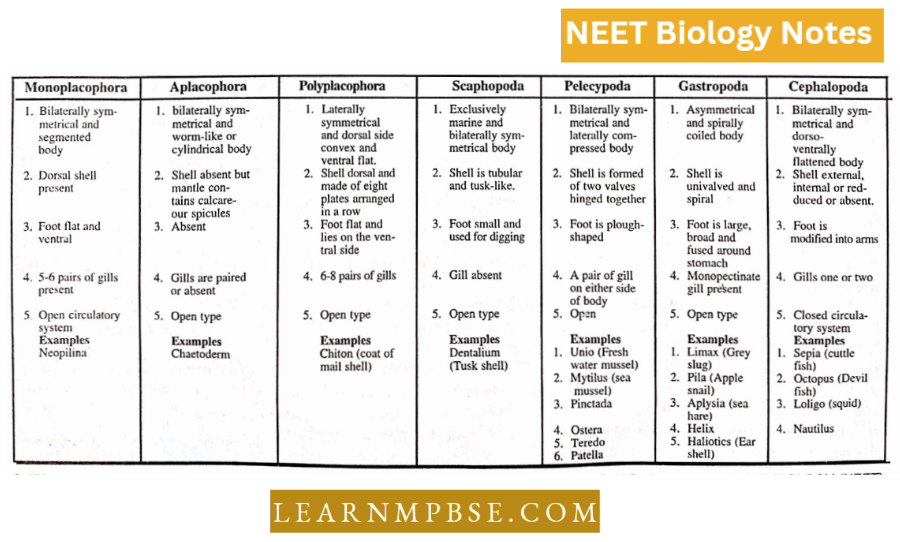
- largest tentacles or arms
- Largest shell
- Smallest shell
- Largest snail
- Largest eye of mollusk
- Slowest moving snail
- Largest Octopus
- Largest gastropod
- The slowest growth in mollusk -Deep Sea clam.
- Torsion is the rotation of body points at an angle of 180° about the head and foot.
- The pallial complex is formed by all organs present in the mantle or pallial cavity.
- Mollusc is a first-rate pollution monitor.
- A slug ( a mollusk) is purely an air breather.
- Organs of Bojanus refer to the kidneys of the freshwater mussel.
- Keber’s organs also help in excretion in some giant squids and upload many tonnes in weight.
- The sea butterfly is a mollusk.
- Neopilina, considered a living fossil,
- Ordovician Period “Age of invertebrates” (also called “Age of Giant Mollusca”)
- Spire. All the whorl of the shell except the body whorl.
- Conchiolin: A horny albuminoid protein of shell.
- The innermost layer of the shell is called the hypostracum or nacreous layer or mother of Pearl.
- Nuchal lobes, also called pseudopodia, are formed of mantle. The left nuchal lobe acts as inhaled, while the right nuchal lobe acts as an exhalant siphon.
- Gilt, also called tedium, of Pila is monopetinate (with one row of gill lamel- ‘Iheff’Om gill axis) and pectinibranch.
- The hypobranchial gland is larger in males. Its secretion lubricates the penis and helps copulation.
- Osphradium is a bipectinate structure (with 2 rows of leaflets).
- Radula. A rasping organ in tire buccal mass and has many rows of teeth. The dental formula of each row is 2, 1, 1, 1, 2.
- The digestive gland is the hepatopancreas which performs the function of the liver, pancreas, and intestine.
- Pila has two chambered kidneys which act as a coelomoduct that connects the pericardial cavity (represents true coelom) to the outside.
- Pila is ammonotelic in water and ureotelic on land.
- Loligo (Squid or sea arrow). Similar to Sepia except that the fins are present only in the posterior half and meet posteriorly.
- Octopus (Devilfish). An octopod marine mollusk with 8 sucker-bearing arms but no tentacles. It kills the prey with its poisonous saliva. It has good learning power and can be trained.
- Nautilus has an external, coiled, and chambered shell. It floats by secreting a gas in the chambers. The animal lives only in the last chamber.
Classification Of Animal Kingdom For NEET Phylum Echinodermata
General Characters of Phylum Echinodcrmata
- All members are exclusively marine.
- Triploblastic animals.
- Larva is bilaterally symmetrical, adults become secondarily radially symmetrical (pentamerous symmetry).
- The body bears spines and calcareous ossicles.
- Coelom is cnterocoelic.
- No distinct heart is present.
- Classification of Echinodermata
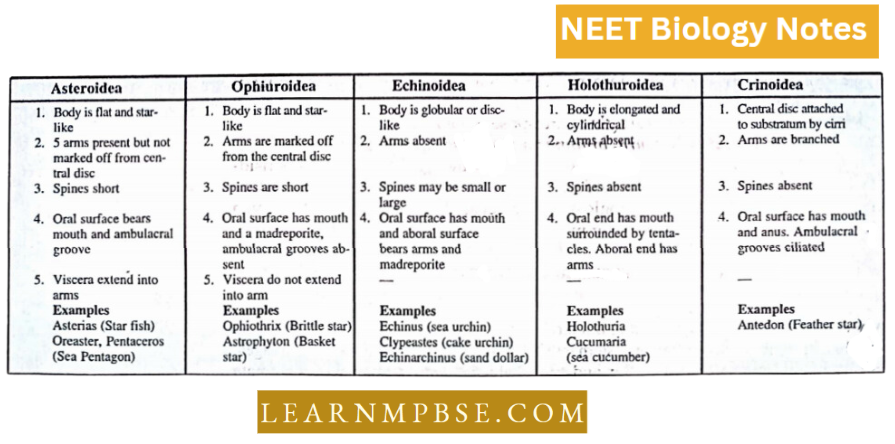
- Locomotion takes place by tube feet.
- The water-vascular system is a characteristic feature of the phylum Echinodermata.
- The water vascular system helps in locomotion and respiration.
- In some echinoderms, respiratory trees, branchiae, or bursae are present for respiration.
- Coelom is in the form of the haemal system which is concerned with blood circulation. Points.
- The digestive system is simple, alimentary canal is complete.
- No special organs for excretion. Exclusively takes place by amoebocytes.
- Nervous system without brain or central nervous system.
- Sexes are separate.
- The great power of regeneration.
- Fertilization is external, in seawater.
- Development is indirect.
- Larva is pluteus or auricularia or bipinnaria.
- Bilaterally symmetrical larva metamorphoses into a radially symmetrical adult.
Important Information
- The term ‘Echenodermate’ was coined by J. Klein.
- The water vascular system of echinoderms is coelomic in origin.
- The endoskeleton is formed of calcareous dermal ossicles that have mesodermal origin.
- Larvae of echinoderms
- Dipleura larva. It is the basic larva and all others are derived from it.
- Bipinnaria larva. Larva of Asteroidea.
- Auricularia. Larva of holothuroidea.
- Ophiplecteus larva ophiuroidea. It is the larva of Echinopletcus
- Doliolaria larva. Larva of sea lilies (Crinoidea)
- Largest starfish-Midgardiaxandaros
- Smallest starfish-Marginastcr carpets
- Aristotle’s lantern-wheel-like saw apparatus of Echinoidea.
- The starfish can open bivalves by attaching two arms with the help of tube feet to either side of a bivalve, pulling it apart. The bivalve tires and opens out.
- The stomach of the starfish is everted through the mouth and introduced into the open mollusk where it is partly digested before being ingested.
- Echinoderms predate on coral polyps also.
- Echinoderms flourished in the Cambrian period.
- Astcrias (Starfish)
- Commonly known starfish are Asterias, Pentaceros, Astropecten, Solaster, Heliaster, Asterina, etc.
- The mouth is also called actinostomc.
- Bivium. Two arms between which madreporite is present.
- Trivium. The remaining three arms of starfish.
- Pedicellariae of starfish are pedunculate and forcipate (with 2 jaws).
- The digestive glands of starfish are 5 pairs of pyloric eerie.
- Digestion is r.vtni corporeal (digestive juices released outside to digest prevent Tietlmnnn’s bodies Nine in number in starfish and probable form the phagocytic amoebocytes.
- Axial gland. Also called Hrougland. Suppose’ to K’ heart,
The development includes diplexer, bipinnaria, and bracbiolaria larvae. - The Tornaria larva was first of all discovered by J. Meiller in and was considered by him as the larva of echinoderms, after in 1850.
- Metschnik established that it is a larva of Balanoglossus clavigerus, The name Maria is given to it because of its habit of rotating in circles.
Classification Of Animal Kingdom For NEET Phylum-Hemichordata
Unique features
- Body soft, unsegmented, worm-like, bilaterally symmetrical.
- Triploblastic animals have an organ system level of organization and without appendages.
- The body is divided into proboscis, collar, and trunk which represents the inner tricoelomate organization.
- The digestive tract is complete, either straight with a terminal anus or 11 shape with an anus near the mouth.
- Buccal diverticulum or stomochord. Earlier regarded as notochord present in the proboscis as a hollow outgrowth of the alimentary canal.
- A dorsal heart with two longitudinal vessels (dorsal and ventral) interconnected by lateral vessels and sinuses open type of circulatory system.
- Respiration through one pair to many gill slits or general surface of the body.
Excretion through proboscis gland or glomerulus. - Sexes may be separate or united. Life history includes a free-swimming larval stage called tornaria larva.
- Examples-Balanoglossus (Acorn worm or Tongue worm)
- Affinities with chordates Resemblances. Presence of gill slits, dorsal hollow single, non-ganglionated nerve cord ‘and so-called notochord.
- Differences. No chordate character resembles in the true sense. Absence of head, paired app£rida£es. tail, endoskeleton, and presence of single-layered epidermis, Affinities, and echinoderms
- Both have poorly developed nervous system
- Both have the same pattern of coelom and open out and filled with water.
- The Larva of Balanoglossus named tornaria resembles the bipinnaria larva of starfishes
The cellular grade of organization can be observed in all protozoans. Animal cells are diverse in structure and function lack a rigid cell wall and are quite flexible. Based on the complexity of the organization metazoans are divided into two subkingdoms i.e. Parazoa and Eumetnzoa.
- Coelom formation in schizocoelomata takes place by the splitting of mesodermal pouches present on the lateral sides of the prospective gut and in enterocoelomata by the growth of lateral mesodermal pouches from the endoderm.
- The animal kingdom includes about 35 phyla of which
11 are considered major phyla. - About 99 percent of animals are invertebrates and the remaining represent vertebrates.
- Unicellular protists animals are included in protozoa and about 15,000 species are known.
- Locomotory structures of Protozoans are flagella, cilia, pseudopodia or absent as in sporozoa.
- Euglena, Amoeba, Paramecium, Noctilucn, and Elphidium are free-living protozoan, Monocystis, Entamoeba, Plasmodium, Trypanosoma and Giardin are parasitic protozoan.
- The size of theifiers ranges from l cm to l meters in length. Some members of porifers are radially symmetrical but huger ones are asymmetrical.
- Sponges reproduce asexually by fragmentation or budding.
- Sycon (scypha), Spongilla, Proterion (Neptune’s cup), Cliona (Dead man’s finger).
- Euspongia (Bath sponge) and Euplectellu aa common examples of sponges.
- Cnidarians exhibit two basic body forms, the Polyp (fixed and feeding) and medusa five swimming and reproductive Coclenterates (Cnidarians) show polymorphism.
